LG Electronics USA VS985 GSM/WCDMA/CDMA/LTE PHONE + BLUETOOTH & DTS/UNII a/b/g/n/ac + NFC User Manual Manual 1
LG Electronics MobileComm USA, Inc. GSM/WCDMA/CDMA/LTE PHONE + BLUETOOTH & DTS/UNII a/b/g/n/ac + NFC Manual 1
Contents
Manual 1

User Guide XXXXXXXXXXX (1.0)
This booklet is made from 98% post-consumer recycled paper.
This booklet is printed with soy ink. Printed in Mexico
User Guide
Guía del
Usuario
VS985
VS985
VS985
LG-VS985_VZW_UG_Cover_V1.0_140218.indd 1 14. 2. 18. 10:56
Copyright©2014 LG Electronics, Inc. All rights reserved.
LG and the LG logo are registered trademarks of LG Group
and its related entities are registered. All other trademarks
are the property of their respective owners.
LG-VS985_VZW_UG_Cover_V1.0_140218.indd 2 14. 2. 18. 10:56

1
Important Customer Information
Before you begin
Before reading this user guide and getting started, please review the
separate Product Safety and Warranty Information guide for important
product safety and warranty information about your device.

2
Important Customer Information...............................................1
Table of Contents .......................................................................2
The Basics ...................................................................................5
Phone Overview .................................................................................................... 5
Help ....................................................................................................................... 8
Non-Removable Battery ...................................................................................... 8
Optional: Remove the SIM Card ......................................................................... 8
Charging the Phone ............................................................................................. 9
Optimizing Battery Life ......................................................................................10
Turning the Phone On and Off ..........................................................................12
Phone’s Status Icons ..........................................................................................15
Getting to Know the Home Screen ................................................................... 17
Touchscreen ......................................................................................................... 21
Hardware key control mode ............................................................................. 27
Applications: How to View, Open, and Switch .................................................28
Working with Menus ..........................................................................................35
Managing Notifications .....................................................................................36
Searching Your Phone and the Web .................................................................40
Locking the Screen ............................................................................................43
Guest mode ........................................................................................................46
Customizing the Home Screen .........................................................................48
Connecting to Networks and Devices ................................... 50
Connecting to Mobile Networks .......................................................................50
Connecting to Wi-Fi Networks ..........................................................................51
USB connection .................................................................................................53
SmartShare ......................................................................................................... 54
Calls .......................................................................................... 57
Placing and Ending Calls .................................................................................. 57
Answering or Rejecting Calls ............................................................................60
Working With the Recent tab ...........................................................................62
Calling Your Contacts.........................................................................................64
Options During a Call ........................................................................................65
Managing Multiple Calls ....................................................................................66
Listening to Your Voicemail ............................................................................... 67
Table of Contents

3
Table of Contents
Web ........................................................................................... 69
Chrome ................................................................................................................69
Communication ....................................................................... 79
Contacts .............................................................................................................. 79
Messaging ........................................................................................................... 86
Email ....................................................................................................................93
Voicemail ............................................................................................................. 98
Gmail ...................................................................................................................99
Hangouts ........................................................................................................... 106
Entertainment ........................................................................ 108
Camera .............................................................................................................. 108
Video Camera .................................................................................................... 115
Gallery ............................................................................................................... 120
Video Player ...................................................................................................... 125
Video Editor ..................................................................................................... 126
Play Store .......................................................................................................... 128
Music ................................................................................................................. 130
YouTube™ .......................................................................................................... 135
Tools .........................................................................................136
VuTalk ................................................................................................................ 136
QuickMemo ...................................................................................................... 139
QSlide ................................................................................................................. 141
QuickTranslator ................................................................................................ 143
QuickRemote .................................................................................................... 144
Calendar ............................................................................................................ 146
Calculator .......................................................................................................... 150
Alarm/Clock ...................................................................................................... 152
Maps .................................................................................................................. 155
Weather ..............................................................................................................157
Voice Mate ........................................................................................................ 158
Voice Recorder ................................................................................................. 159
POLARIS Office 5 ............................................................................................ 161
File Manager ..................................................................................................... 162
Tasks .................................................................................................................. 164

4Table of Contents
Settings ...................................................................................165
Safety ........................................................................................191
Consumer Information About Radio Frequency Emissions ......................... 194
Consumer Information on SAR ..................................................................... 198
FCC Hearing-Aid Compatibility (HAC) Regulations
for Wireless Devices ........................................................................................ 200
Caution:
Avoid potential hearing loss. .......................................................................... 202
TIA Safety Information ................................................................................... 203
Safety Information .......................................................................................... 206
FDA Consumer Update ................................................................................... 210
Specifications .........................................................................221
FAQ .........................................................................................222
LIMITED WARRANTY STATEMENT ...................................228
Index .......................................................................................232

5
The Basics
Phone Overview
Front View
Proximity
Sensor
Quick Keys
Back Key
Home Key
Menu Key
Home Screen
Earpiece
Front Camera
Lens
NOTES s All screen shots in this guide are simulated. Actual displays may vary.
s Instructions to perform tasks in this guide are based on the default settings and may
change depending on the mode and software version on your phone.
1. Proximity Sensor Senses proximity toward other objects (such as your
head) so that tap commands are not accidentally activated during a call.
It also employs an ambient sensor which measures the surrounding light
and adjusts the LCD brightness to provide a vivid screen.
NOTES s Do not block the sensor or near the sensor to avoid problems with the touchscreen.
2. Front Camera Lens Use to take pictures and record videos of yourself.
You can also use this for video chatting. Keep it clean for optimal
performance.
3. Quick Keys Provide quick, one-touch access to the applications you use
most often.
NOTE You can change the icons in the Quick Keys bar to suit your needs. To reposition, add, or
remove an icon, see pages 18.
4. Back Key Returns to the previous screen. Also closes pop-up items such
as menus, dialog boxes, and the on-screen keyboard.
5. Home Key Returns to the Home screen (or returns to your default
Home screen canvas from any of the Home screen extension canvases)
Touch and hold it to display recently used applications with access to the
Task Manager application.

6The Basics
6. Menu Key Opens an Options menu with options that affect the current
screen or application. This only applies when available, depending on the
screen or application.
7. Home Screen Displays all of the information needed to operate your
phone, such as applications, call status, date, time, signal status, and
battery strength.
8. Earpiece Lets you hear callers and automated prompts.
Rear View
Rear Camera
Lens LED Flash
Wireless
Charging Area
Volume Keys
Power/Lock Key
NFC Touchpoint
WARNING For your safety, do not attempt to remove the embedded battery from the phone.
9. Rear Camera Lens Use to take photos and record videos. Keep it clean
for optimal performance.
10. Power/Lock Key Press to lock/unlock the screen. Press and hold to turn
the phone on/off, restart it, activate/deactivate airplane mode, and
change the sound settings.
11. NFC Touchpoint Tap the back of your phone to an NFC tag or another
NFC compatible device in this location.
12. Wireless Charging Area Allows you to charge your device using a
wireless charging pad (sold separately) instead of the USB cable. The
integrated antenna is also inside this back area of the phone.
13. Volume Keys Allow you to adjust the ringer, the media volumes, or the
in-call volume during a call.
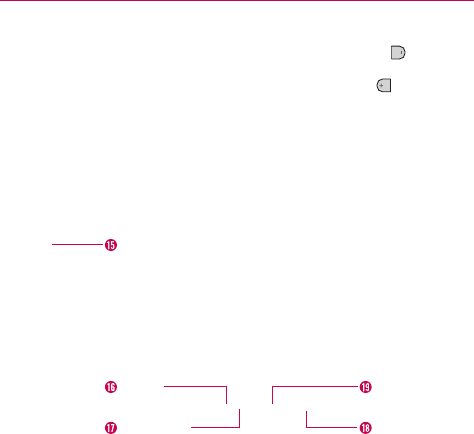
7
The Basics
TIP s With the screen asleep (dark), press and hold the Volume Down Key to activate
the camera.
s With the screen asleep (dark), press and hold the Volume Up Key to access
QuickMemo.
14. LED Flash Brightens up the captured image or recorded video when
you turn on the flash.
Left Side View and Bottom View
SIM Card Tray
USB/Charger
Port
Speaker Microphone
3.5mm
Headset Jack
15. SIM Card Tray Allows you to insert your SIM card. A valid SIM card is
required to have access to the mobile network.
NOTE This phone comes with the SIM card preinstalled.
16. 3.5mm Headset Jack Allows you to plug in an optional headset for
convenient, hands-free conversations. You can also plug in headphones
to listen to music.
17. Microphone Transmits your voice to the other caller and is used for
voice-activated functions.
18. Speaker Sound comes from the rear speaker instead of the earpiece
(e.g., the speakerphone function, music player function, etc.).
19. USB/Charger Port Allows you to connect the phone and the USB Cable
for use with the charger adapter, or other compatible accessories.
NOTE You may purchase a separate fast data cable from LG to enjoy higher data transfer speed
with compatible devices (e.g. laptop).
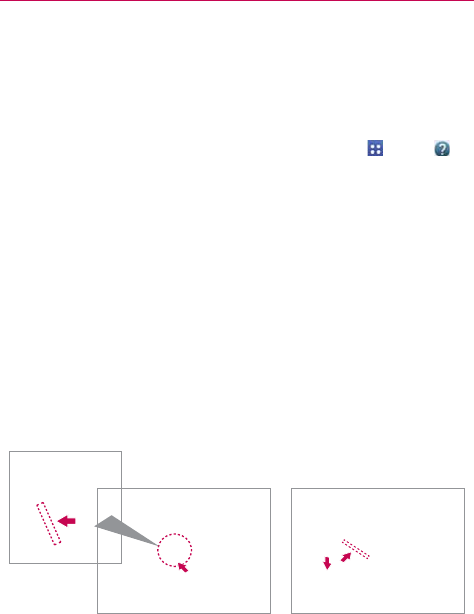
8The Basics
Help
The Help application allows you to quickly and conveniently view
information about your phone, including how-to videos, Icon glossary, Quick
reference guide, etc.
To access Help, from the Home screen, tap the Apps Key
> Help
.
Non-Removable Battery
Your phone has an internal, rechargeable battery that should be replaced
only by LG or an authorized LG repair center. You should never try to open
or take apart this phone yourself. Opening the phone can cause damage
that will void your warranty.
Optional: Remove the SIM Card
NOTE The SIM card is pre-installed in your smartphone. If you need to replace your SIM card,
follow the below instructions.
1. Place your fingernail in the cutout and pull the SIM card tray out.
2. Place the SIM card into the tray with the contacts facing down.
3. Carefully put the tray back in the slot and push it gently into the phone.

9
The Basics
Charging the Phone
Your phone comes with a USB Cable and an adapter which connect
together to charge your phone. Correctly orient the USB/Charger plug
before inserting it to avoid damaging your phone.
NOTE Please only use an approved charging accessory to charge your LG phone. Improper
handling of the USB/Charger Port, as well as the use of an incompatible charger, may
cause damage to your phone and void the warranty.
1. Correctly orient the USB Cable with the adapter, and connect them. As
shown below, both the USB logo on the USB Cable and the LG logo on
the adapter will face toward you.
USB Cable Adapter
2. The USB/Charger Port is located at the bottom of the phone. Correctly
orient the cable with the port before plugging it in. As shown below, the
USB logo on the cable will face upward.
3. Plug the adapter into an electrical outlet to begin charging.
Charging with the USB cable
NOTE
Make sure to correctly orient the cable with
the port before plugging it in. When the
phone is facing upward, the USB logo on the
cable will also face upward.
USB Cable
You can use your computer to charge your phone. To be able to charge with
the USB Cable, you need to have the necessary USB drivers installed on
your PC first. Connect one end of the USB Cable to the USB/Charger Port
on your phone (as shown above) and connect the other end to a USB port
on your PC. It is best to use the rear USB port when connecting to a
desktop PC. The USB hub should be powered by an external power source.
NOTE You may experience a slower charging rate when charging from your computer.

10 The Basics
Optimizing Battery Life
You can extend your battery’s life between charges by turning off features
that run in the background. You can also monitor how applications and
system resources consume battery power.
Tips to extend the life of your battery
㻌 Turn off radio communications that you aren’t using. If you aren’t
using Wi-Fi, Bluetooth, or GPS, use the Settings menu to turn them
off (Note that the GPS receiver is only turned on when you’re using an
application that makes use of it).
㻌 Turn down screen brightness and set a shorter screen timeout.
㻌 Turn off automatic syncing for Gmail, Calendar, Contacts, and other
applications if you don’t need it.
㻌 Use the Battery saver feature (accessed in the Settings menu) to
control data activity, Wi-Fi connection, Bluetooth connection, and power
used for the device such as screen brightness and notification light.
NOTES s Allowing other devices to use your device's hotspot connection will drain your battery
more quickly.
s If you accidently press the Power/Lock Key while the device is in your pocket, the
screen will turn off automatically in order to save battery power.
To check the battery charge level
From the Home screen, tap the Apps Key > Settings > Battery.
The battery level (as a percentage of fully charged) and the battery
status (Charging or Discharging) is displayed at the top of the screen.
Checkmark the Battery percentage checkbox to display the
percentage of remaining battery charge on the Status Bar next to the
battery icon.
Tap Battery saver to view and/or modify your Battery saver settings.

11
The Basics
To monitor and control what uses the battery
The Battery use screen allows you to see which applications are consuming
the most battery power. Information on this screen allows you to identify
downloaded applications you may want to turn off when not being used, so
you can get the most out of your battery power.
㻌 From the Home screen, tap the Apps Key > Settings
> About
phone > Battery > Battery use. The top of this screen displays a
usage graph and below it, battery usage times. It lists all of the
applications or services using battery power from the greatest amount
of energy used to the least amount.
㻌 Tap an application or service in the Battery use screen to see the
details about its power consumption, including either how long since
last connected to a power source or how long you were last running
on battery power. Different applications or services offer different
kinds of information, and they may even include options to modify the
settings so you can reduce power consumption by that application.
Battery saver mode
If the battery charge level drops to low levels, the phone automatically
activates Battery saver mode (if set to On) to conserve battery power until
you can recharge it.
㻌 From the Home screen, tap the Apps Key
> Settings
> Battery
>
Battery saver > Turn Battery saver on. Set the desired option,
then tap the switch at the top right corner of the screen to toggle it off
or on.
㻌 You can set the phone to activate Battery saver mode immediately,
when the charge drops to 10%, 20%, 30%, or 50%. If you turn off
Battery saver mode, when the battery charge becomes low, a
notification prompts you to turn it on.
㻌 You can also modify settings that affect battery life from the Battery
saver screen: Auto-sync, Wi-Fi, Bluetooth, Vibrate on touch,
Brightness, Screen timeout and Notification light.

12 The Basics
Turning the Phone On and Off
Turning the phone on
㻌 Press and hold the Power/Lock Key on the back of the phone for a
couple of seconds until the screen turns on.
Turning the phone off
1. Press and hold the Power/Lock Key on the back of the phone until
the Phone options menu appears.
2. Tap Power off in the Phone options menu.
3. Tap OK to confirm that you want to turn off the phone.
Turning the screen on using the KnockON feature
The KnockON feature allows you to double-tap the screen to easily turn the
screen on or off. You can disable this feature in the Gestures settings.
Quickly double-tap the center of the screen to turn the screen on.
Quickly double-tap the Status Bar, an empty area on the Home
screen, or the Lock screen to turn the screen off.
NOTES s The KnockON feature can be turned off in the Gestures menu. From the Home
screen, tap Apps > Settings > Gestures > tap the KnockON checkbox .
s When turning the screen on, make sure you do not cover the proximity sensor.
Doing so will not allow you to turn the screen on.
To unlock the phone
If you don’t use the phone for a while, the screen and
backlight will turn off to conserve battery power. To
unlock the phone:
1. Turn the screen on.
Press the Power/Lock Key on the back of the
phone. The default Lock screen will appear.
NOTE Avoid covering the proximity sensor when turning the screen
on. Doing so, immediately turns the screen off.
OR

13
The Basics
Quickly double-tap the center of the screen (KnockON).
2. From the center of the screen, swipe in any direction to unlock it.
To use a shortcut, swipe the shortcut icon at the bottom of the screen
in any direction. The screen will unlock and launch the application.
NOTE The default Lock screen simply locks the screen to prevent unintentional actions. For
more security to guard against unauthorized use, you can set an unlock requirement
(such as a pattern, PIN, password, or face recognition) that will need to be entered to
unlock it.
To turn the phone sounds off
If you’re in a place where your phone sounds may disturb others, you can
quickly silence your phone from the Home screen.
From the Home screen, press and hold the Power/Lock Key on
the back of the phone, then tap the Silent mode icon .
NOTE Only one mode can be selected at a time. The currently activated mode (Silent ,
Vibration , or Sounds ) is underlined in blue. Tap any of the sounds mode icons to
switch to that mode.
OR
Press the down Volume Key on the back of the phone until vibration
is set, then press it again to turn all sounds off. Sounds are turned off or
vibration is set.
OR
Open the Notifications panel and tap the Sound icon until is displayed.
Your Google Account
You must sign into a Google Account to use Gmail, Hangouts, Google
Calendar, and other Google Applications; to download applications from the
Play Store; to back up your settings to Google servers; and to take
advantage of other Google services on your phone.
IMPORTANT
ţ If you don’t have a Google Account, you’re prompted to create one.
ţ If you don’t sign into a Google Account during setup, you are prompted to sign in or to
create a Google Account the first time you start an application that requires one, such
as Gmail or Play Store.
ţ When you sign in, you’re prompted to enter your username and password using the
on-screen keyboard.

14 The Basics
ţ After you sign in, your contacts, Gmail messages, Calendar events, and other
information from these applications and services on the web are synchronized with
your phone.
ţ If you have an enterprise account through your company or other organization, your IT
department may have special instructions on how to sign into that account.
Setting up your Google Account
If you use Setup Wizard to set up your Google Account, it guides you
through the following steps.
1. At the Google Account setup screen, tap Ye s if you already have a
Google Account, or tap No if you want to create a new account.
2. Enter your username and password or any other necessary information
(if creating an account), then tap the Continue icon . Tap OK to agree
to your Google Account terms and conditions.
NOTE Tap the Back Key in the Front Touch Keys bar to close the on-screen keyboard.
3. Choose to join Google+ which makes sharing on the web more like
real-life sharing. You can choose Circles, Instant Upload, and Messenger.
Tap Join Google+ or Not Now.
4. Choose whether or not to set up your credit card information for Play
Store purchases.
5. Complete the Backup and restore screen to allow your Google Account
to back up your apps, settings, and other data, then tap the Continue
icon .
Your Gmail, Google Contacts, and Google Calendar events will all be
synchronized with your phone automatically.
NOTE This is automatic for the first Google Account you add. When adding additional Google
accounts, you have to select which options to synchronize.
6. Read the Google and Location screen, set your sharing preference, then
tap the Continue icon .
7. Read the Verizon mobile screen, then tap Next.
8. Confirm your setup checklist choices, then tap Done.
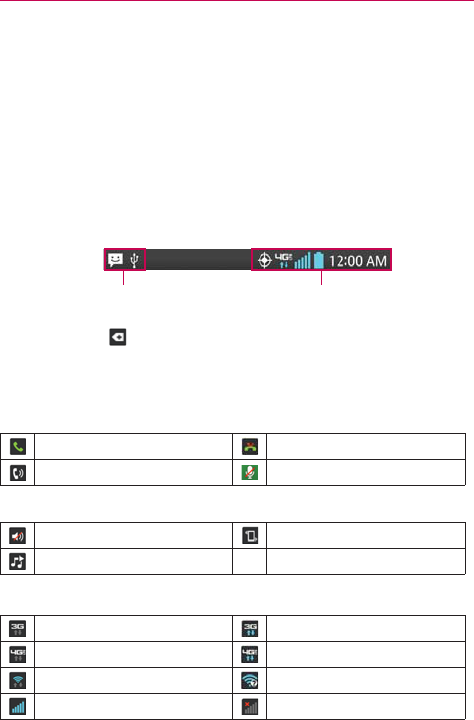
15
The Basics
You can use the area below to record your Google Account information for
future reference.
Username:___________________________________________@gmail.com
Password:____________________________________________
Phone’s Status Icons
The Status Bar appears at the top of every screen. It displays icons
indicating that you’ve received notifications (on the left) and icons indicating
the phone’s status (on the right), along with the current time.
Notification icons Status icons
If you have more notifications than can fit in the Status Bar, the More
notifications icon is displayed as an indicator to open the Notifications
panel to view them all.
The following icons may appear in the Status Bar.
Call icons
In call Missed call
Speakerphone is on Microphone is muted
Sound icons
Silent mode is activated Vibrate mode is activated
Music is playing
Network icons
3G connection 3G in use
4G LTE connection 4G LTE in use
Wi-Fi connection Wi-Fi within range
Signal strength No signal
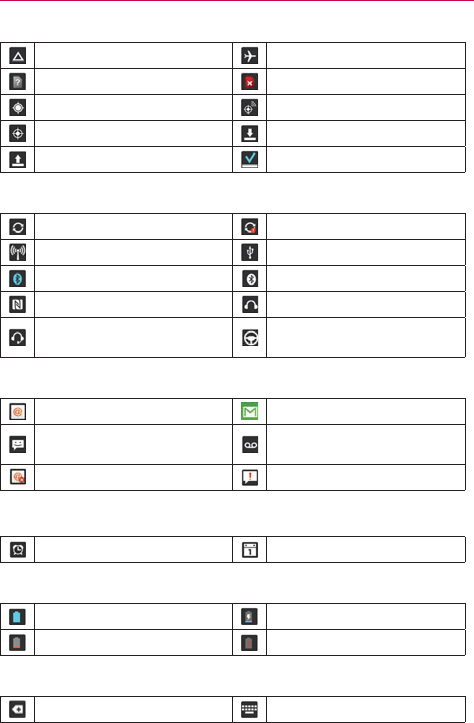
16 The Basics
Roaming Airplane mode is activated
Unknown SIM card No SIM card
GPS is on Location service is on
Location service is off Downloading
Uploading Download successful
Connectivity icons
Syncing Problem with sign-in or sync
Mobile Hotspot is on USB connection
Bluetooth connection Bluetooth is on
NFC is on Headset is connected
Headset with microphone is
connected Driving mode is on
Email and Messaging icons
New email New Gmail message
New text or multimedia
message New voicemail
Sent email unsuccessful Sent message unsuccessful
Calendar and Alarm icons
Alarm is set Upcoming event
Battery icons
Full battery Charging battery
Low battery Empty battery
Other icons
More notifications available Choose input method
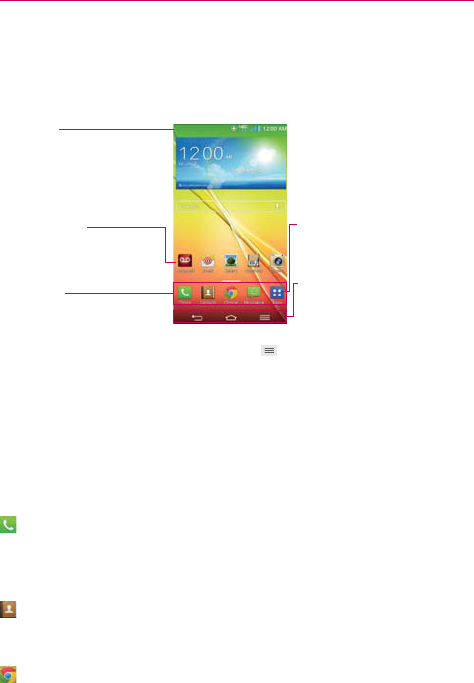
17
The Basics
Getting to Know the Home Screen
The Home screen is your starting point to access all of the features on your
phone. It displays application shortcuts, icons, widgets, and other features.
Status Bar
Shows device status
information, including the
time, signal strength, battery
status, and notification icons.
Application Icon
Tap an icon (application,
widget, folder, etc.) to open
and use it.
Quick Keys
Provide easy, one-touch
access to the functions used
most often.
Apps Key
Tap here to open the Applications
screen to view all of your installed
applications.
Front Touch Keys
Displayed on all screens, these keys
allow you to easily navigate within
the device software.
NOTE From the Home screen, tap the Menu Key (in the Front Touch Keys bar), tap Home
screen settings, then checkmark Portrait view only to keep the Home screen from
rotating to landscape view. This is a separate setting from the Auto-rotate screen
setting that applies to the rest of the screens.
Quick Keys
The Quick Keys are located in a bar at the bottom of the Home screen (in
portrait view).
NOTE Five icons are displayed, but the Quick Keys bar can hold up to seven icons. You can
modify the icons in this bar to suit your needs.
: Opens the Phone application which displays the dialpad so you can dial
a number not stored in your phone’s memory. It also provides additional
tabs at the top of the screen to access your Recent calls, Contacts,
Favorites, and Groups.
: Opens the Contacts application which displays the names and numbers
stored in your phone's memory. It also provides additional tabs at the top of
the screen to access the dialpad, your Recent calls, Favorites, and Groups.
: Opens the Chrome application to access the web browser.

18 The Basics
: Opens the Messaging application so you can send and view text and
multimedia messages.
: Opens the Applications screen which displays phone options and
applications. It also provides a Widget tab, a Search icon , and an Edit
icon at the top of the screen.
Modifying the Quick Keys Bar
You can modify the icons in the Quick Keys bar to suit your needs.
㻌 Rearrange: Touch and hold the icon to move, then drag it to another
position in the Quick Keys bar.
㻌 Add: Open the Applications screen, then drag the icon you want onto
the Quick Keys bar.
㻌 Delete: Touch and hold the icon to delete, then drag it to the Remove
icon that appears at the top of the screen.
Front Touch Keys
The Front Touch Keys are displayed in a bar at the bottom of all of the
screens to provide easy navigation within the device software.
NOTE The Front Touch Keys are displayed along the right side of the screen when the phone is
held sideways.
Back Key: Tap to back up one step at a time and close on-screen items
such as pop-up messages, the on-screen keyboard, etc.
Home Key: Tap to immediately return to the Home screen. Touch and
hold to access your Recent apps list.
Menu Key: Tap to display the available Options menu.
To return to the Home screen
㻌 Tap the Home Key (in the Front Touch Keys bar) at any time, from
any application.
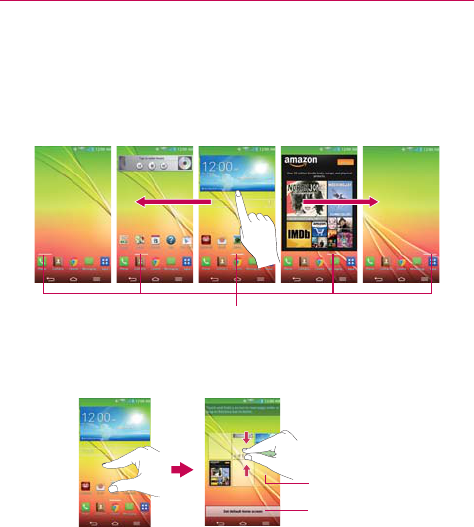
19
The Basics
To view other Home screen canvases
㻌 Swipe (or flick) your finger left or right across the Home screen. The
Home screen is comprised of five sliding canvases, but you can add
up to seven canvases to allow more space for icons, widgets,
shortcuts, and other items.
Home Screen Canvas Indicator
The white line above the Quick Keys indicates which
Home screen canvas you are viewing.
㻌 Pinch in on the Home screen to display the mini canvas view, then tap
the Home screen canvas you want to view.
Tap here to set the
default Home screen.
Tap here to add
another canvas.
Full screen view Mini canvas view
Mini canvas view
Mini canvas view allows direct access to any of the Home screen canvases
and also allows you to manage them. You can add, delete, and rearrange
the canvas order to suit your needs.

20 The Basics
Pinch in on any of the Home screen canvases to change from full screen
view to mini canvas view. From mini canvas view you have the following
options:
㻌 To go directly to any canvas, simply tap the one you want.
㻌 To add another canvas, tap the Add canvas icon .
㻌 To delete a canvas, touch and hold the canvas to delete, drag it to the
Remove bar at the top of the screen, then lift your finger.
㻌 To rearrange your canvases, touch and hold the canvas to move, drag
it on top of the canvas position where you want it, then lift your finger.
The moved canvas takes that position and the remaining canvases
shift accordingly.
㻌 To set another canvas as the default Home screen, tap the Set
default Home screen bar at the bottom of the screen, then tap the
screen you want to set as the default Home screen canvas.
Hiding items on the Home screen
Place two fingers on the screen, then spread them apart to hide the items
on your Home screen so that only your wallpaper and the Status Bar are
displayed. To redisplay your normal Home screen with all of its applications
and widgets, pinch in on the screen, or tap the Back Key (in the Front
Touch Keys bar).
NOTE The device automatically reverts to the normal Home screen view after screen timeout.
Using Dual View
Dual view allows you to easily add items to any of the Home screen
canvases. Touch and hold an empty spot on any of the Home screen
canvases to view your Home screen on top and the Applications screen on
the bottom. Flick sideways to scroll through the Home screen canvases to
display the canvas you want. At the bottom of the screen, tap the type of
item you want to add (Apps, Widgets, or Wallpapers), then flick sideways
to scroll through the available choices. Simply tap the item you want to
automatically add it to the canvas viewed at the top of the screen.
NOTE The Quick Keys are not accessible while in Dual view.
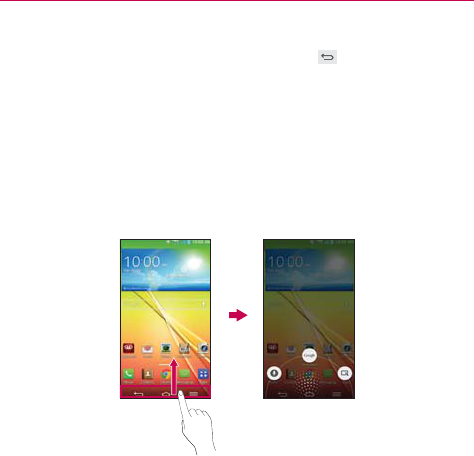
21
The Basics
To return to the full screen view, tap the Back Key (in the Front Touch
Keys bar). You can also tap one of the Home screen canvases.
NOTE The device automatically reverts to full screen view after screen timeout.
Global access
To open Voice Mate, Google Now, or QuickMemo from any screen, in
portrait view, place your finger on the Front Touch Keys bar at the bottom
of the screen and drag upward until you see the Global access icons, then
let go over the app you want.
NOTE Make sure to place your finger on the bar between the Front Touch Keys to activate this
feature.
Touchscreen
Your touchscreen provides an excellent way to interact with and use your
Android™ phone. With the touch of your finger, you can download and use
available applications, make menu selections, and access data saved to
your phone.
The following terms are used for describing the different available actions
using the touchscreen:
Touch or tap A single finger touch selects items. For example, tap an
icon (e.g., an application, widget, or folder), tap words (e.g., menu

22 The Basics
selection or to answer an on-screen question), or touch letters and
numbers to type.
Touch and hold Touch and hold an item on the screen by touching it and
not lifting your finger until an action occurs. For example, to open a
Context menu for editing a contact, touch and hold a contact entry until
the menu pops up.
Drag Touch and hold an item for a moment and then, without lifting your
finger, move your finger on the screen until you reach the target position.
For example, you can drag items on the Home screen to reposition them.
Swipe, slide, or flick Move your finger quickly across the surface of the
screen, without pausing when you first touch it (so you don’t drag an item
instead). For example, you can browse through the different Home
screens by swiping from left to right (and vise versa), slide the screen up
or down to scroll a list, or remove an application from the Recent apps
screen by flicking its graphic off the screen.
Double-tap Tap the screen twice quickly to zoom, highlight text, or turn
the screen on/off. For example, quickly double-tap a section of a web
page to zoom that section to fit the width of the screen and control the
zoom in Maps and in other applications. Double-tap a word to highlight it.
Double-tap can also activate the KnockON feature to turn the touchscreen
on or off.
Pinch-to-zoom Use your index finger and thumb in a pinch motion (to
zoom out) or spread motion (to zoom in) when using Chrome, a map,
photos, the rear camera lens, the Contacts list, the Favorites list, the
Groups list, the Messaging list, a music list, and POLARIS Office 5
documents. Spread apart to make screen information larger (easier to see
and read), or pinch together to view more area and information. The pinch
gesture also changes the Home screen. Pinch in on the Home screen to
change to mini canvas view, then spread apart to return to the normal
Home screen view. Spread apart on the normal Home screen to hide all of
your Home screen items, then pinch in to redisplay them.
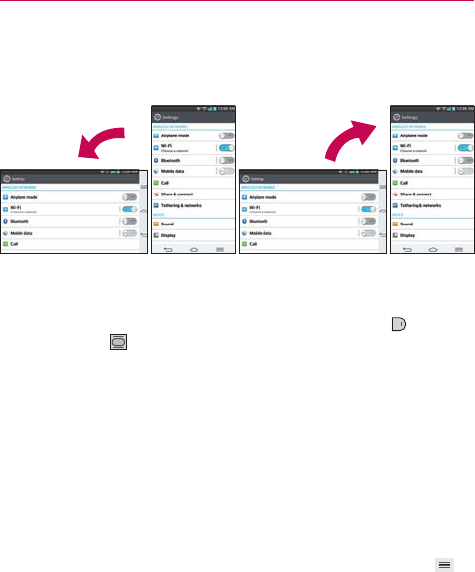
23
The Basics
Rotate the screen From many applications, the orientation of the screen
rotates with the phone as you turn it from upright to sideways and back
again. You can deactivate this function in the Display settings menu.
Rotate the phone sideways for
landscape orientation.
Rotate the phone upright for portrait
orientation.
Capturing the screen Press and hold the Volume Down Key
and the
Power/Lock Key on the back of the device at the same time to capture
the current image on the screen. You can find the captured image in the
Gallery application.
NOTE You cannot capture an image from some videos and applications.
The Smart screen and Smart video features
The Smart screen and Smart video features keep the device from activating
screen timeout when it detects your eyes looking at the screen. When you
turn these features on, you can set a shorter screen timeout setting to
conserve your battery power, but still allow you to view a screen for a
longer period of time without having to touch it to keep it activated.
To turn these features on, from the Home screen, tap the Menu Key (in
the Front Touch Keys bar) > Settings > Display > checkmark the Smart
screen checkbox and/or the Smart video checkbox.
NOTE The following situations may prevent these features from functioning properly:
s When the device is in the dark or against bright light.
s When the front camera cannot detect the location of your eyes.
s When the front camera is used at the same time with other applications.
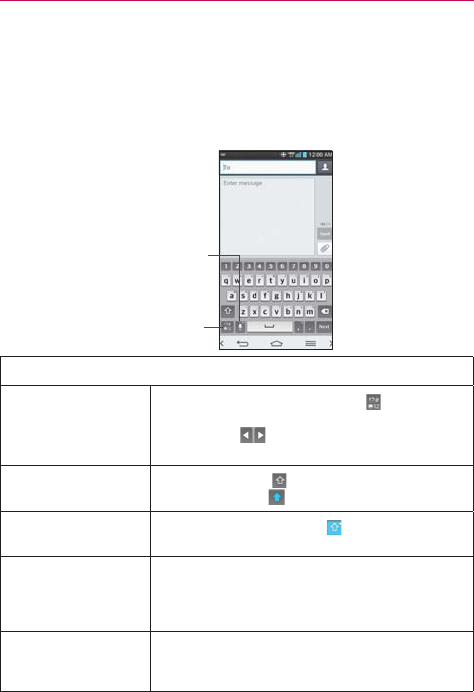
24 The Basics
Text Input Methods
On-screen Keyboard
The on-screen keyboard displays automatically on the screen when you
need to enter text. To manually display the on-screen keyboard, simply tap
a text field where you want to enter text.
Touch and hold to enter text
by voice and handwriting or
or access the clip tray and
keyboard settings.
Toggles between 123/SYM
mode and ABC mode.
Typing tips
Enter other
characters
Tap the Numbers/Symbols Key to display
the numbers and symbols keyboard. Tap the
Arrow Keys on the left side of the keyboard
to view additional symbols.
Enter one capital
letter
Tap the Shift Key to capitalize the next letter.
The key changes .
Enter all capital
letters
Double-tap the Shift Key ( displayed) to set to
caps lock. Tap again to revert to lowercase.
Highlight text
Double-tap a word to highlight it. To highlight a
range of text, double-tap a word, then drag the
blue highlight markers to highlight the text you
want.
Cut or copy selected
text
Highlight the desired text, then tap Cut or Copy
in the action box displayed above the highlighted
text.
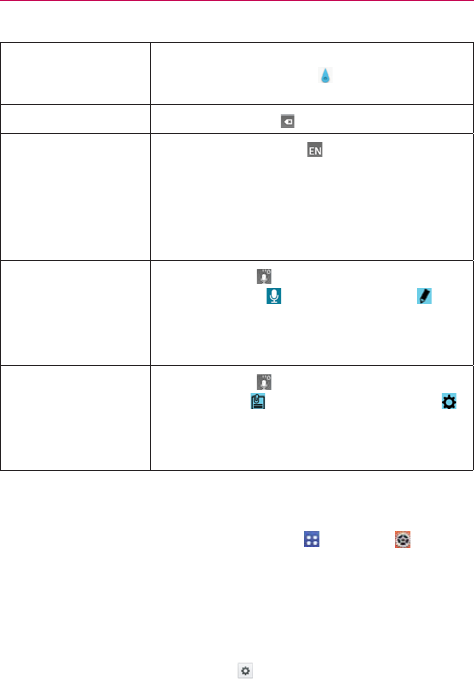
25
The Basics
Paste cut or
copied text
Tap the location where you want to paste the
text, then tap the marker . Tap Paste in the
action box that appears.
Delete a character Tap the Delete Key .
Language toggle
Tap the Language Key to toggle between
the languages you set in the Input language and
type menu. Touch and hold this key to modify
your language settings.
NOTE This key is only available when multiple languages have
been enabled for text entry.
Entering text by
voice or handwriting
Touch and hold and drag your finger to the
Voice input icon or Handwriting icon .
NOTE The Voice input key is the default option for the LG
Keyboard. If you select the handwriting option, the
Handwriting Key will be displayed instead.
Accessing the Clip
Tray and keyboard
settings
Touch and hold and drag your finger to the
Clip Tray icon or Keyboard Settings icon .
NOTE The Voice input key is the default option for the LG
Keyboard. If you select the Clip Tray or Keyboard Settings
option, the chosen key will be displayed instead.
Text input settings
To change your text entry settings and see the dictionary of terms you’ve
used, from the Home screen, tap the Apps Key > Settings >
Language & input. The following options are available in the KEYBOARD
& INPUT METHODS section.
Default - Allows you to choose the default keyboard to use when
entering text.
Google voice typing - Checkmark to select Google voice typing to
enter text. Tap the Settings icon to change the Google voice typing
settings.

26 The Basics
Choose input languages: Allows you to select the languages to
support with Google voice typing.
Block offensive words: Checkmark to hide recognized offensive text.
Download offline speech recognition: Enables voice input while
offline.
LG Keyboard - Tap the Settings icon to change the following
settings.
Input language and type: Allows you to select the keyboard
language and type. This is where you can select multiple languages
for your keyboard input.
Word suggestion: Allows you to set auto correction, suggest next
word, advanced word suggestion, and clear history.
Auto capitalization: Checkmark to automatically capitalize the first
letter of each new sentence.
Auto punctuation: Checkmark to automatically insert a period when
you double-tap the Space Key.
Voice input: Checkmark to show the Voice Input Key on the
keyboard.
Path input: Checkmark to enter a word by drawing a path through all
of the letters.
Handwriting: Allows you to set the handwriting style. Set the pen
type (width), color, delay time, and gestures used when your
handwriting is translated to text on the device.
Keyboard gesture: Allows you to select gestures to use for Hide
keyboard, Split keyboard, and One-handed operation.
Additional settings: Allows you to set the additional settings that
include Keyboard theme, Extend keyboard, Vibrate on keypress,
Sound on keypress, and Preview on keypress.
Help: Displays text input settings information.

27
The Basics
Languages
You can set only one default language for your device, but you can set
multiple languages used for the on-screen keyboard.
To change the default language
From the Home screen, tap the Apps Key (in the Quick Keys bar)
> Settings > Language and input > Language > tap the
language you want.
To add additional languages for your keyboard
From the Home screen, tap the Apps Key (in the Quick Keys bar)
> Settings > Language and input. Tap the Settings icon to the
right of LG Keyboard, tap Input language and type, then checkmark
the languages you want the keyboard to be able to use.
OR
Open the Notifications panel (when an app that allows text input is
open), tap Choose input method > Setup input methods > the
Settings icon to the right of LG Keyboard > Input language and
type, then checkmark the language you want to be able to use.
Hardware key control mode
If your phone display is damaged or broken, you can answer an incoming
call, end a call, or turn off an alarm using the hardware keys.
1. Turn your phone off.
2. Press and hold the Power/Lock Key and the Volume Keys at
the same time for more than 6 seconds to enter the Hardware key
control mode.
3. Press the Volume Keys to scroll to the desired option, then press
the Power/Lock Key to confirm.
Answer a call: Press the Volume Keys at the same time.
End a call: Press the Power/Lock Key during a call.
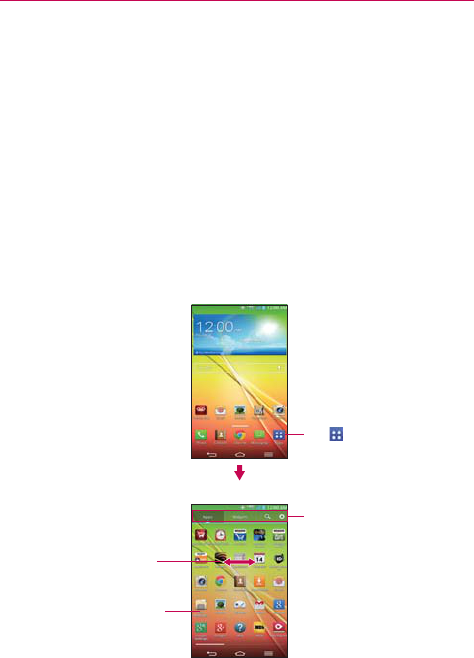
28 The Basics
Stop an alarm: When an alarm rings, press and hold the Volume Up
Key or Volume Down Key to stop the alarm.
NOTE If you use your phone with a broken display glass, your phone can break even more or
you can be injured. Make sure to visit the LG authorized service center to get your phone
repaired.
Applications: How to View, Open, and Switch
All of the applications on your phone, including any applications that you
downloaded and installed from Play Store or other sources, are grouped
together on the Applications screen, which you access from your Home
screen. If you have more applications than can fit on the Applications
screen, you can slide the screen left or right to view more.
Home screen
Applications screen
Tap an application icon to
open the application.
Tap these to select Apps,
Widgets, Search, or Edit.
Tap to open the
Applications screen.
Slide the screen left or
right to bring more icons
into view.

29
The Basics
Opening and Closing the Applications screen
Opening the Applications screen
It’s easy to access the Applications screen no matter what feature you’re
currently using. Simply tap the
Home Key
(in the Front Touch Keys bar),
then tap the Apps Key
(in the Quick Keys bar).
Closing the Applications screen
To manually close the Applications screen, tap the Home Key or the
Back Key in the Front Touch Keys bar.
NOTE The Applications screen closes automatically when you tap an icon to open its application.
Dragging an icon onto your Home screen also closes the Applications screen automatically.
Customizing the Applications screen
The phone includes a wide variety of applications and you can download
even more applications to your device. You can customize these items on
the Applications screen for faster, more convenient access (less scrolling)
to the applications you use most often.
Applications screen options
You can change the look of your Applications screen.
1. From the Home screen, tap
the Apps Key
(in the Quick Keys bar)
.
2. Tap the Menu Key (in the Front Touch Keys bar) to access the
following Applications screen options:
View apps by: Tap to sort your applications either in alphabetical
order, by downloaded date, or user customized.
Show small/large icons: Tap to change the application icons to either
small or large, then tap Yes to set your choice.
Apps wallpaper: Tap to change the wallpaper background. Scroll
horizontally to view all of your choices, tap the one you want, then tap
Apply.

30 The Basics
Hide/Show apps: Tap to set which application icons will be displayed
in your Applications screen. Checkmark the icons you want to hide,
then tap OK.
Rearranging the Applications screen icons
You can rearrange the order of the icons on the Applications screen to
provide more convenient access to the applications you use the most.
1. From the Home screen, tap the Apps Key (in the Quick Keys bar).
2. Tap the Menu Key (in the Front Touch Keys bar), tap View apps by,
then tap User customized.
3. Tap the Apps tab at the top of the screen (if necessary), then tap the
Edit icon at the top right of the tab bar. changes to a checkmark
.
4. Touch and hold the Application icon you want to move, drag it to its new
position, then lift your finger. The remaining icons shift to the right.
NOTE If you drag the application icon onto another application icon, it creates a folder with both
of the applications in it.
Checking application information
To check on an application’s detail information from the Applications screen:
1. From the Home screen, tap the Apps Key (in the Quick Keys bar).
2. Tap the Apps tab (if necessary), then tap the Edit icon at the top right
of the tab bar. changes to a checkmark .
3. Tap any of the Application icons to display an information dialog box.
4. Tap OK to exit.
NOTE The Edit icon also allows you to display an information dialog box for a widget you
select.
Opening and Switching Applications
Multi-tasking is easy with Android™ because you can use and switch
among several open applications. Android™ manages each application,
stopping and starting them as needed, to ensure that idle applications don’t
consume resources unnecessarily.
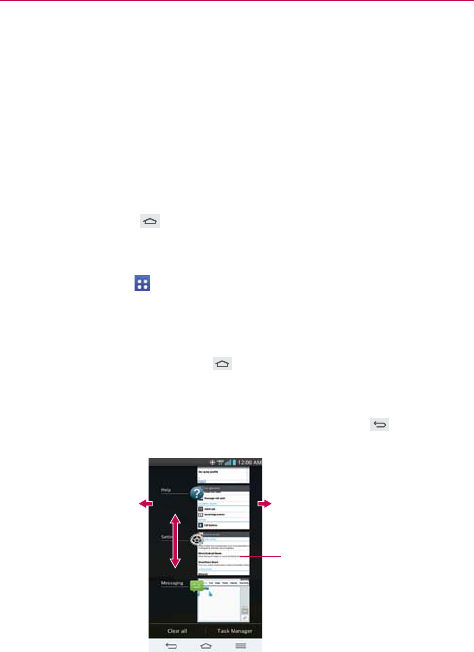
31
The Basics
Opening an application
Open an application simply by tapping its icon on the screen.
TIP You can customize your Home screen with the application icons you use most often.
Applications are located on the Applications screen, but you can copy any application
icon to your Home screen for faster, more convenient access. No matter where the icon
is, on the Applications screen or your Home screen, just tap it to open and use it.
Opening multiple applications
1. Tap an application icon to open it.
2. Tap the Home Key (in the Quick Keys bar).
NOTE If the application icon you want is on your Home screen, simply tap the icon to open and
use it.
3. Tap the Apps Key (in the Quick Keys bar).
4. Tap the icon for the other application you want to open.
Switching between multiple applications
1. Touch and hold the Home Key (in the Front Touch Keys bar). A
screen opens and displays a scrolling list of all of the applications that are
currently open.
2. Tap the application you want to use or tap the Back Key (in the Front
Touch Keys bar) to return to the current screen.
Tap an icon to use it.
You can also tap the application image,
but if you tap the screen background,
you return to the Home screen.
Flick an application icon to the right or
left to close the application and remove
it from the list.
Swipe up or down to view
the entire list of open
applications.
NOTE Navigation in the Recent apps screen depends on the device orientation. When held
sideways, swipe left and right to view the entire list. Flick an application icon up or down
off the screen to close the application and remove it from the list.
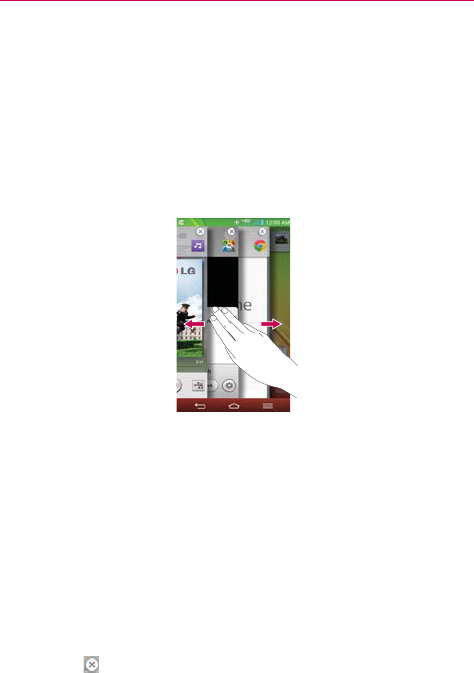
32 The Basics
Slide Aside
Slide Aside allows you to quickly switch between three open applications
(or tasks) using a three finger gesture.
NOTE The Slide Aside feature does not recognize fewer fingers, additional fingers, or your palm.
1. While an application is open, place three fingers on the screen and slide
to the left. The current screen is saved and the Home screen appears.
2. To re-open the saved apps, place three fingers on the screen and slide to
the right. Tap the desired app you want to open.
NOTE You must be in an application, not on the Home screen, to use Slide Aside.
Using the Slide Aside feature
After activating the Slide Aside screens you want to use:
Place three fingers on the screen and slide them to the right. A
fanned-out portion of each screen is displayed. Tap one to open and
use it.
While viewing a Slide Aside screen, use three fingers to slide the
screens to the right or left to scroll through the screens one at a time.
NOTE Slide Aside screens do not scroll circularly. You cannot slide the far right screen to the
left. When you slide it to the right, the fanned-out portions are displayed.
Tap the icon in the upper-right corner of a Slide Aside screen to
close it.

33
The Basics
Adding items to the Home screen
Customize your Home screen with the applications you use most often.
Applications screen
1. From the Home screen, tap the Apps Key (in the Quick Keys bar).
NOTE You can tap the tab at the top of the screen to place a widget on the Home screen.
2. Touch and hold the icon you want to add to your Home screen. The
Applications screen closes and the Home screen is displayed.
3. Lift your finger to place it or drag the icon to where you want it on the
screen, then lift your finger.
Dual view
1. Touch and hold an empty spot on any of the Home screen canvases to
view your Home screen on top and the Applications screen on the
bottom.
2. Flick sideways to scroll through the Home screen canvases to display
the canvas you want.
3. Tap the type of item you want to add (Apps, Widgets, or Wallpapers) at
the bottom of the screen, then flick sideways to scroll through the
available choices.
4. Tap the item you want to automatically add it to the canvas viewed at
the top of the screen.
Moving applications to other Home screen canvases
You can place application icons on any of the Home screen canvases.
Drag Touch and hold, then drag the icon to the left or right edge of the
screen to advance to the other screen canvases before lifting your finger.
Tilt Touch and hold an item, then tilt the device to move it to one of the
Home screen canvases in that direction, then lift your finger.
NOTE To be able to use the Tilt method, the Move Home screen items checkbox needs to be
checkmarked. From the Home screen, tap the Menu Key > Settings > Gestures >
Move Home screen items checkbox.
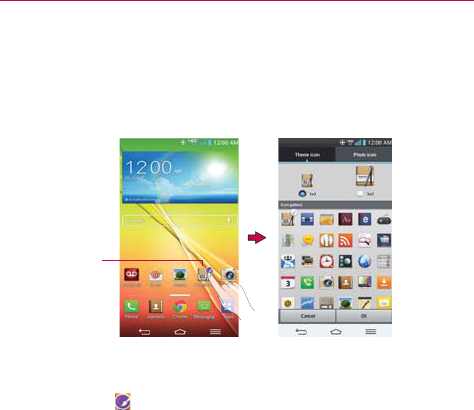
34 The Basics
Customizing an application icon on your Home screen
You can create your own custom application icon(s) using the images in
your Gallery. Your customized application icon(s) are only applied to icons on
your Home screen. The Applications screen is not affected.
Touch, hold, release,
then tap an icon to
edit it.
Customize Icon
Screen
Home Screen
1. Touch and hold the icon you want to customize, then release the icon.
An editing icon appears at the upper right side of the application icon.
NOTE If an icon you placed can be resized, you will see a blue box around the icon after you
touch, hold and release it. Drag the edges of the box to resize it.
2. Tap the application icon.
3. Tap the icon design you want from the available Theme icon choices
and change the size (if desired), then tap OK.
OR
㻌Tap Photo icon, then tap Add new. Set the size for the icon, then tap
OK. Select the image you want to use for the application. Crop the
image if necessary, then tap OK.
NOTE Your custom photo icons are saved so you can easily select them for any of your icon
images.
Changing an icon into a widget
Some application icons can be changed into a convenient widget to use on
your Home screen.
1. Touch and hold the icon you want to customize, then release the icon.
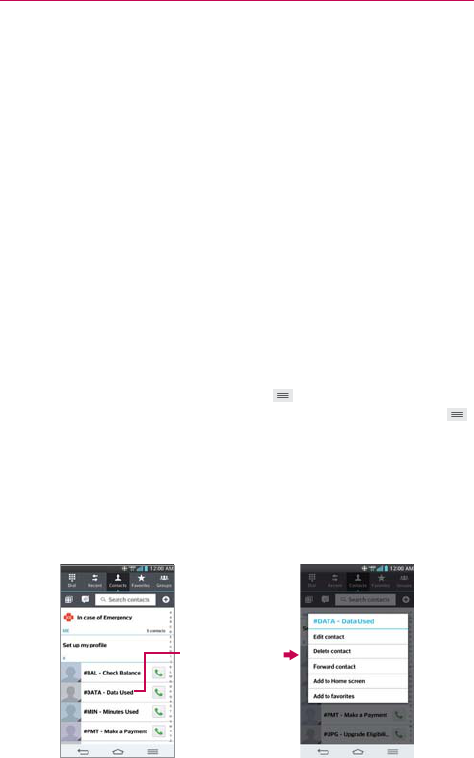
35
The Basics
㻌 A blue frame appears around the icon if it can be resized and changed
into a widget (if it can’t, only the Edit icon is displayed).
2. Drag the corners of the frame to make it larger and change it into a
widget.
㻌 Touch, hold, and release the widget again to change the size of the
widget, if necessary.
㻌 You can also change it back into a normal icon by dragging the corners
of the resizing frame back in.
Working with Menus
There are two kinds of Android menus: Options menus and Context
menus.
Options menus
Options menus contain tools that apply to the activities of the current
screen or application, not to any specific item on the screen. To open the
available Options menu, tap the Menu Key (in the Front Touch Keys
bar). Not all applications have Options menus; if you tap the Menu Key
on a screen that has no Options menu, nothing will happen.
Context menus
Context menus contain options that apply to a specific item on the screen.
To open a Context menu, touch and hold an item on the screen. Not all
items have Context menus. If you touch and hold an item that has no
Context menu, nothing will happen.
When you touch and
hold certain items on
a screen, a Context
menu opens.
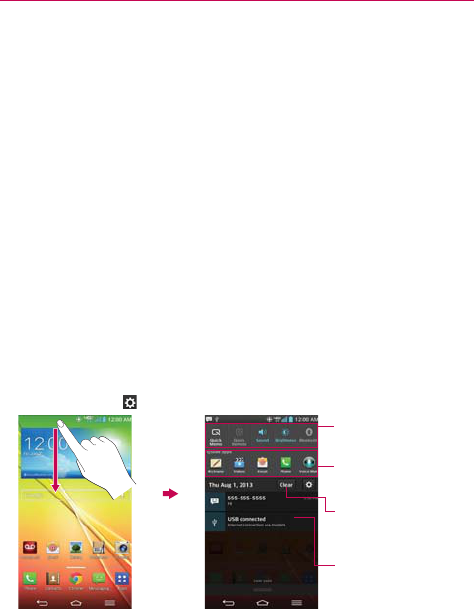
36 The Basics
Managing Notifications
Notification icons report the arrival of new messages, calendar events,
alarms, as well as ongoing events, such as when you are in a call.
When you receive a notification, the notification icon will be displayed in the
Status Bar. You can open the Notifications panel to view a list of all of your
recent notifications. Depending on your settings, you may hear a
notification sound, and/or see a notification light, and/or the phone may
vibrate.
To open the Notifications panel
Touch and drag the Status Bar to the bottom of the screen.
The Notifications panel displays a list of your current notifications, organized
into ongoing and event-based notifications. It also includes two icon bars.
The Quick Settings bar allows you to quickly and easily change commonly
used settings. The QSlide apps bar allows you to view an application in a
small, moveable window (similar to picture-in-picture on a TV).
NOTE You can also access the complete Settings menu from this panel by tappinig the
Settings icon .
Clear Button
Tap here to clear your list of
event-based notifications.
Tap a notification to open it.
Quick Settings Bar
Flick right or left to scroll
through the list.
QSlide Apps Bar
Tap to activate a QSlide
feature.
Home screen Notifications Panel

37
The Basics
To respond to a notification
1. Open the Notifications panel. Your current notifications are listed in the
panel, each with a brief description.
2. Tap a notification to view it.
The Notifications panel will close and the application that corresponds to
your response will open. For example, new voicemail notifications dial
your voicemail box and Gmail notifications open the Gmail application so
you can read your new messages.
To clear all notifications
1. Open the Notifications panel.
2. Tap the Clear button on the right side of the screen.
All event-based notifications will be cleared; ongoing notifications will
remain in the list.
To close the Notifications panel
Touch and drag the handle at the bottom of the Notifications panel to
the top of the screen or just tap the Back Key (in the Front Touch Keys
bar).
The panel will also close when you touch a notification.
NOTE You can also flick the Notifications panel handle upward to quickly close it.
Quick settings on the Notifications panel
The top of the Notifications panel includes a Quick settings bar. The icons in
this bar provide a quick, convenient way to change settings without
accessing any applications. If you set more than five icons on the bar,
swipe left and right to scroll through the list.
Using the Quick settings icons
Tap any of the Quick settings icons to toggle through the available settings:
QuickMemo .
QuickRemote .
Sound On , Vibrate , or Silent .

38 The Basics
Brightness Full , Half , Off , or Manual .
Bluetooth On or Bluetooth Off .
Wi-Fi On or Wi-Fi Off .
GPS On or GPS Off .
Rotation screen On or Rotation screen Off .
Airplane mode On or Airplane mode Off .
Quiet mode On or Quiet mode Off .
Screen timeout 30 seconds , 5 minutes or 15 minutes .
Wireless storage .
Battery saver On or Battery saver Off .
Mobile Data On or Data Off .
Miracast On or Miracast Off .
NFC On or NFC Off .
QSlide Apps Bar displayed or QSlide Apps Bar hidden .
Sync On or Sync Off .
NOTE If necessary, scroll horizontally to see all of the available icons.
Tap the Settings icon (on the left side of the Clear button ) to
access the complete Settings menu.
Customizing the Quick settings bar icons
You can set the order of the icons displayed in the Quick settings bar as
well as which icons are displayed.
1. Open the Notifications panel, then tap the Edit icon at the right side
of the Quick settings bar.
Drag one of the icon handles at the right side of the screen to
move its icon to another position in the Quick settings bar.
Checkmark each of the items you want to appear in the Quick
settings bar.
NOTE Changing the checkmarks reorganizes the icons in the Quick settings bar.

39
The Basics
2. Tap the Back Key (in the Front Touch Keys bar) to return to the
Notifications panel.
QSlide apps on the Notifications panel
QSlide apps are displayed in a bar on the Notifications panel below the
Quick settings bar. These icons provide a quick, convenient way to multi-
task on the same screen (similar to picture-in-picture on a TV). QSlide
displays a small application window on the screen that can be moved,
resized, or made transparent.
Using the QSlide apps
Tap any of the QSlide apps in the bar to activate it. When activated, the
QSlide feature opens the application in a window in the foreground,
allowing you to access other applications in the background. You can open
up to two QSlide windows at a time.
Drag the QSlide title bar to move it to another position on the screen.
Drag the bottom right corner of the QSlide window to resize it.
Move the circle on the slider bar to the left to make it transparent.
This will allow you to interact with items beneath the transparent
QSlide window. Move the slider back to the right to use the QSlide
window again.
Tap the QSlide icon at the upper-left corner of the title bar to open
the application in full screen view. To go back to QSlide view tap the
QSlide icon at the top of the screen.
Tap at the upper-right corner of the title bar to close the QSlide
window.
Customizing the QSlide bar apps
You can set the order of the apps displayed in the QSlide bar, as well as
which apps are displayed.
1. Open the Notifications panel, then tap the Edit icon on the far right of
the QSlide apps bar.
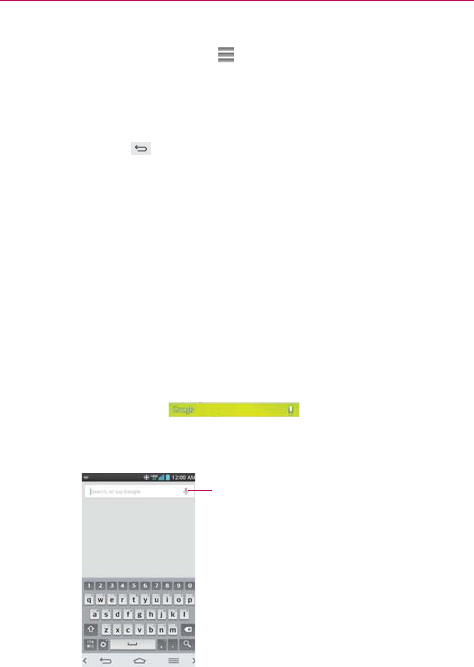
40 The Basics
Drag one of the icon handles at the right side of the screen to
move its icon to another position in the QSlide apps bar.
Checkmark the QSlide apps you want to display and remove the
checkmark for the ones you want to remove.
2. Tap the Back Key (in the Front Touch Keys bar) to return to the
Notifications panel.
Searching Your Phone and the Web
You can search for information on your phone and on the web using the
Google search application.
Some applications, such as Gmail, Contacts, and Chrome have the ability to
search for contents within those specific applications.
You can conduct the search by typing in the search terms or saying what
you’re looking for. As you enter text, the search application can provide
suggestions so you don’t necessarily have to type out your full request.
Phone and Web search using text entry
1. Tap the Search Widget on the Home screen.
Google Search opens automatically and the on-screen keyboard is
displayed.
Voice Search
Tap here to search by voice.
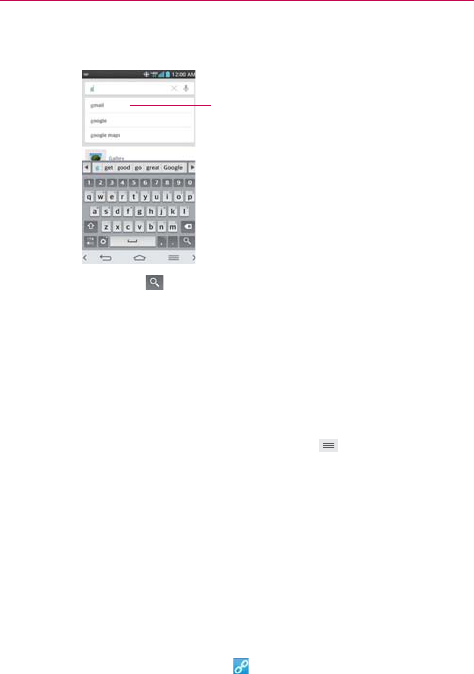
41
The Basics
2. Enter the text you’re searching for in the search box.
As you type, search results from your
phone, previous search terms, and
web search suggestions appear. Tap
an item to activate that search result.
3. Tap the Search Key on the on-screen keyboard to use the Google
application to search for the text you entered in the search box.
Search preference settings
You can use the Search preference settings to configure some aspects of
web search (for example, whether it makes suggestions below the search
box as you type) and what phone features you want to include in your
searches. To access these settings:
1. From the Search application, tap the Menu Key > Settings.
2. Tap Phone search.
3. Tap an item to checkmark and enable it (or remove the checkmark) to
set your search preferences.
Text Link
Text Link recommends apps related to text in messages or other text
you’ve selected. It connects directly to the Calendar, Contacts, Phone,
Messaging, Email, Web, Maps, YouTube, Calculator, and more.
To use Text Link:
Tap a message bubble with the icon.
Highlight text on a webpage or e-mail and select Text Link in the
pop-up.
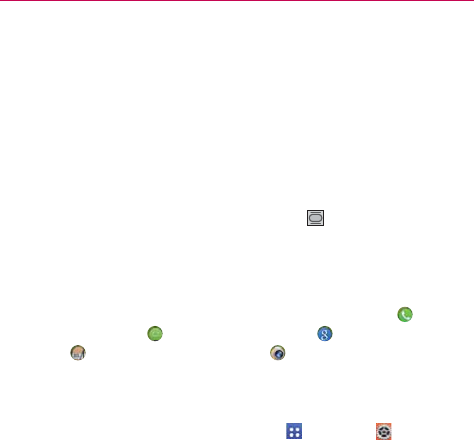
42 The Basics
Tap Share and select Text Link.
NOTE s If your phone is set to English or Korean, Text Link performs more functions than in
other language settings.
s Overly long sentences are subject to limitations.
s Arithmetic operators (such as +, -, * and /) start the Calculator.
s If Text Link is not linked to an app, the Browser can be used for searching.
The default Lock screen
The default Lock screen is Swipe which protects against unintentional
touchscreen actions. Press the Power/Lock Key on the back of the
phone to illuminate the touchscreen if it has timed-out. The Swipe default
Lock screen is displayed, but you can still conveniently check the date,
time, and Status Bar icons. You can drag the Status Bar down to open and
use the Notifications Panel without unlocking the screen. In addition, you
can also quickly access five applications (the Phone application , the
Messaging application , the Google application , the Notebook
application , and the Camera application ) without fully unlocking the
screen. Simply swipe an icon upward to open and use it.
Changing the items on the default Lock Screen
1. From the Home screen, tap the Apps Key > Settings > Lock
screen.
2. Tap Shortcuts.
3. Tap one of the icons at the bottom of the screen, then tap the application
you want to replace it with.
4. Tap Save to save these settings.
NOTE You can access Shortcuts when the lock screen is set to Swipe.

43
The Basics
Locking the Screen
You can lock your phone so that only you can unlock it to make calls, access
your data, buy applications, and prevent unauthorized use.
Setting a Screen Lock for the First Time
1. From the Home screen, tap the Apps Key > Settings
> Lock
screen.
2. Tap Select screen lock.
3. Tap None, Swipe, Face Unlock, Pattern, PIN, or Password.
None: No lock screen is enabled so the screen will never be locked from
use.
Swipe: A swipe motion in any direction on the touchscreen will unlock
the screen. This is the default Lock screen.
Face Unlock: Unlocks the screen using face recognition. The phone
captures your image to identify you. Keep in mind that Face Unlock is
less secure than a pattern, PIN, or password because it uses generalized
shape and dimension to verify your face.
Pattern: Unlocks the screen using a pattern you draw with your finger.
The first time you set an unlock pattern, you will see a tutorial with
instructions on how to create it. Read the tutorial, then tap Next. Draw
your pattern (connect at least 4 dots) and tap Continue. Then redraw
your pattern and tap Confirm.
NOTE Follow the on-screen instructions to create a backup PIN number in case you forget your
pattern.
PIN Unlocks the screen with a number sequence. Enter a PIN (at least 4
digits) and tap Continue. Reenter your PIN and tap OK to confirm it.
Password Unlocks the screen with an alphanumeric sequence. Enter a
password (at least 4 characters) and tap Continue. Re-enter your
password and tap OK to confirm it.
From then on, any time you want to unlock the screen, you will need to
perform the unlock action you set (swipe, face recognition, pattern, PIN,
or password) to gain access to it.

44 The Basics
Disabling the Screen Lock
1. From the Home screen, tap the Apps Key > Settings > Lock
screen.
2. Tap Select screen lock.
3. Confirm your unlock information (if necessary).
4. Tap None.
Changing Your Screen Lock
1. From the Home screen, tap the Apps Key > Settings
> Lock
screen.
2. Tap Select screen lock.
3. Confirm your unlock information (if necessary).
4. Tap the desired screen lock option.
5. You’re prompted to enter your screen lock.
6. Enter a Backup PIN and tap Continue. Then confirm your Backup PIN
and tap OK.
NOTES s You have 5 opportunities to enter your unlock pattern, PIN, or password. If you used
all of the opportunities, you can try again after 30 seconds.
s If you have set up a Microsoft Exchange account, you might only be able to use a
password.
s If you can't remember your unlock sequence, tap Forgot pattern? in the bottom
right-hand corner of the screen, then you can unlock the phone using your Google
Account (if you created it on the phone) or your Backup PIN that you created when
you set up the screen lock sequence.
- Enter your Google Account username and password, then tap Sign in.
- Enter your Backup PIN, tap Done at the bottom right corner of the keypad, then
tap OK.
Security lock timer
If a security lock is enabled, you can set the delay time after the screen
darkens due to inactivity before the screen automatically locks and requires
you to enter your unlock sequence.

45
The Basics
1. From the Home screen, tap the Apps Key > Settings
> Lock
screen.
2. Tap Security lock timer.
Power button instantly locks
If a security lock is enabled, checkmark the Power button instantly locks
checkbox to override the Security lock timer setting and lock the screen as
soon as the Power/Lock Key is pressed.
1. From the Home screen, tap the Apps Key > Settings
> Lock
screen.
2. Checkmark the Power button instantly locks checkbox.
The Lock screen wallpaper
You can set the Lock screen wallpaper separately from your Home screen
wallpaper.
1. From the Home screen, tap the Apps Key > Settings
> Lock
screen.
2. Tap Wallpaper.
Tap Gallery to select an image from your Gallery.
Tap Wallpaper gallery to select one of the available wallpaper
images.
Additional Lock screen settings
There are additional Lock screen settings depending on which Security lock
you set. The following are all of the settings for each lock screen:
Swipe includes: Select screen lock, Screen swipe effect, Weather
animation, Wallpaper, Shortcuts, Owner info., Security lock timer, and
Power button instantly locks.
Face Unlock includes: Select screen lock, Improve face matching,
Liveness check, Wallpaper, Hidden pattern, Owner info., Security lock
timer, Power button instantly locks, and Make pattern visible.

46 The Basics
Pattern includes: Select screen lock, Pattern effect, Hidden pattern,
Wallpaper, Owner info., Security lock timer, Power button instantly
locks, and Make pattern visible.
PIN includes: Select screen lock, Random PIN, Wallpaper, Owner
info., Security lock timer, and Power button instantly locks.
Password includes: Select screen lock, Wallpaper, Owner info.,
Security lock timer, and Power button instantly locks.
Hard Reset (Factory Reset)
If you forget your lock sequence and backup PIN, you will have to perform
a hard reset to gain access to your phone.
WARNING Performing a hard reset deletes all of your user data, which includes pictures, videos,
and music saved to your internal memory. Please make sure to back up your information
prior to performing a hard reset.
1. Turn the phone off.
2. Press and hold the following keys at the same time: Volume Down Key
+ Power/Lock Key on the back of the phone.
3. Release the Power/Lock Key only when the LG logo is displayed,
then immediately press and hold the Power/Lock Key again.
4. Release all keys when the Factory hard reset screen is displayed.
5. Press the Power/Lock Key to continue or either of the Volume Keys
to cancel.
6. Press the Power/Lock Key once more to confirm or either of the
Volume Keys to cancel.
Guest mode
Use Guest mode when you let someone else use your phone. They will
only be able to use the applications that you’ve selected. Once you set it
up, you can easily put your phone in Guest mode by drawing the guest
pattern on the Lock screen that you set, which is different from your
normal unlock pattern.
NOTE Guests can also use applications that your selected applications link to.

47
The Basics
Setting up Guest mode
1. From the Home screen, tap the Apps Key > Settings > Guest
mode.
2. Tap Set pattern, then set the pattern you want to use to put your device
in Guest mode.
3. Tap Set apps to view which apps can be accessed in Guest mode. Tap
the Add icon in the upper right corner of the screen to change the
Guest apps list.
Checkmark the apps that can be accessed.
Remove checkmarks from the apps that you don't want to be
accessed.
Tap OK when all of the checkboxes are set as you want.
4. Tap Allow Guest mode.
If your Lock screen is not set to Pattern, tap OK, then tap Pattern and
enter your normal lock screen pattern as necessary.
NOTE If your unlock sequence is set to a PIN or password, you will need to enter it to be able
set the unlock pattern.
Using Guest mode
After you’ve set up and enabled Guest mode, lock the screen so that you
can enter your Guest mode pattern. The Guest mode Home screen is
displayed with only the apps you’ve selected for guest access. To exit
Guest mode, enter your normal unlock pattern on the Lock screen.
NOTE The Allow Guest mode checkmark is automatically removed from the checkbox if your
lock sequence is changed from Pattern. Otherwise, manually disable it if you no longer
want to allow guest access.
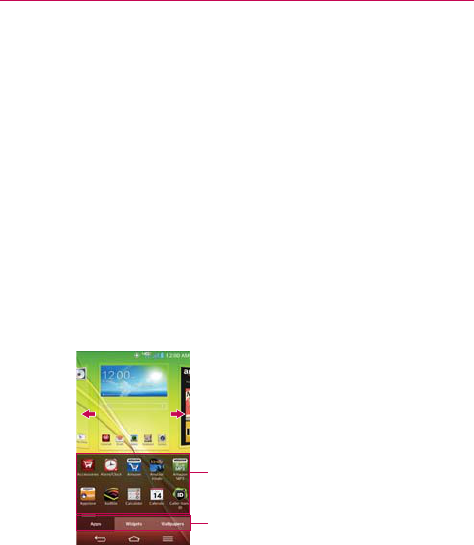
48 The Basics
Customizing the Home Screen
You can personalize your Home screen by adding application icons,
shortcuts, widgets, and other items to any Home screen canvas. You can
also change the wallpaper.
To add an item to the Home screen
1. Go to the Home screen canvas where you want to add the item.
2. Touch and hold an empty spot on the Home screen to split the screen to
display your Home screen canvases on top and the Applications screen
on the bottom.
NOTE If the canvas you've selected is full, make space by deleting or moving items, or switch
to another canvas where there is space for new items.
3. The following three category tabs appear at the bottom of the screen:
Apps, Widgets, and Wallpapers. Tap the one that corresponds to the
item you want to add.
Item List
Touch and hold an icon, then drag it
onto the canvas where you want it.
Category Tabs
Tap one of the item categories you want
to add to a Home screen canvas.
Slide the screen right or left to view
different Home screen canvases.
4. Swipe left and right to scroll through the available choices in the
category tab you selected. Touch and hold the item you want, then drag
it onto the Home screen canvas, or simply tap it to automatically place it
on the canvas.
To move an item on the Home screen
1. Touch and hold the item.
2. Drag the item to a new location on the screen.
Pause at the left or right edge of the screen to drag the item onto the
next available Home screen canvas.

49
The Basics
3. When the item is where you want it, lift your finger.
NOTE If Move Home screen items is enabled in the Gestures menu, simply tilt the device in
the direction you want to move the item and it will slide to the canvases in that direction.
Lift your finger when it arrives at the canvas you want.
To remove an item from the Home screen
1.
Touch and hold the item.
2.
Drag the item to the Remove icon
at the top of the screen.
3. When the Remove icon changes to , lift your finger.
To change the look of your Home screen
From the Home screen, tap the Menu Key > Home screen settings to
access the following settings to personalize your Home screen.
Theme: Sets the overall ambiance of the Home screen. Choose Basic
or Marshmallow.
Wallpaper: Sets the wallpaper. Choose Gallery, Live Wallpapers,
Multi-photo, and Wallpaper gallery.
Screen swipe effect: Sets how the items on the Home screen
canvases slide from one to the next. Choose from Basic, Breeze,
Accordion, Panorama, Carousel, Layer, and Domino.
Allow Home screen looping: Checkmark this setting so that the
Home screen canvases rotate continuously (does not stop at the far
left or right canvas).
Allow apps list looping: Checkmark this setting so that the
Application screen canvases rotate continuously (does not stop at the
far left or right right canvas).
Portrait view only: Checkmark this setting so that the Home screen
is always displayed in portrait view even though you rotate the phone
to landscape view.
Help: Tap to view help information about customizing the Home
screen.
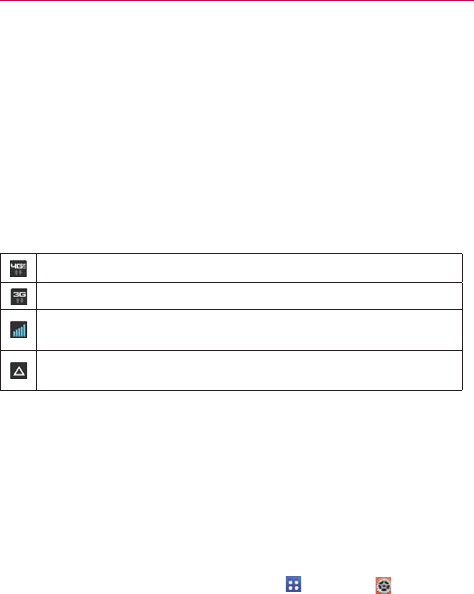
50 Connecting to Networks and Devices
Connecting to Mobile Networks
When you buy your phone and sign up for service, your phone is configured
to use your provider’s mobile networks for voice calls and for transmitting
data.
Different locations may have different mobile networks available.
Initially, your phone is configured to use the fastest mobile network
available for data. You can also configure your phone to access a different
set of networks entirely, or to behave in specific ways when roaming.
The following icons in the Status Bar indicate which kind of data network
you’re connected to and the network signal strength.
Connected to the 4G network (LTE).
Connected to the EVDO network (EVDO revA).
Signal strength - more bars that are lit, the stronger the wireless
signal.
Connected to another wireless service provider’s network
(roaming).
When connected to slower networks, you may want to postpone using
your phone for data-intensive tasks until you are connected to a faster
network again or find a Wi-Fi network to connect to.
To disable data when roaming
You can prevent your phone from transmitting data over other carriers’
mobile networks when you leave an area that is covered by your carrier’s
networks. This is useful for controlling expenses if your cell plan doesn’t
include data roaming.
1. From the Home screen, tap the Apps Key > Settings > Tethering
& networks > Mobile networks > Global data roaming access.
2. Tap Global data roaming to remove the checkmark from the box. You
can still transmit data with a Wi-Fi connection when Global data
roaming is disabled.
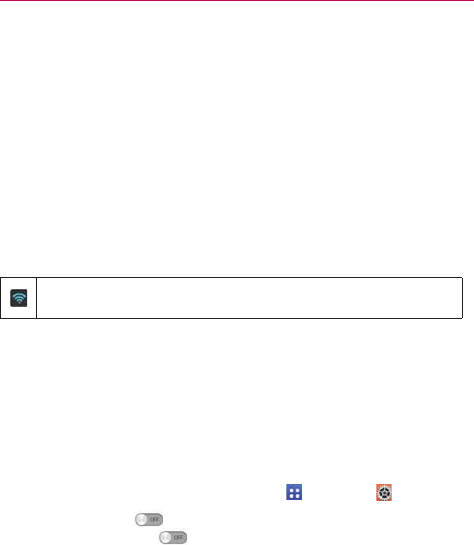
51
Connecting to Networks and Devices
Connecting to Wi-Fi Networks
Wi-Fi is a wireless networking technology that can provide Internet access
at distances of up to 100 meters, depending on the Wi-Fi router and your
surroundings.
To use Wi-Fi on your phone, you must connect to a wireless access point.
Some access points are open and you can simply connect to them. Others
are hidden or implement other security features, so you must configure
your phone so it can connect to them.
Turn off Wi-Fi when you’re not using it, to extend the life of your battery.
The following Status Bar icon indicates your Wi-Fi status.
Connected to a Wi-Fi network (waves indicate connection
strength).
When you connect to a Wi-Fi network, the phone obtains a network
address and other information it needs from the network, using the DHCP
protocol. To configure the phone with a static IP address and other
advanced settings, from the Wi-Fi settings screen, touch and hold the
connected network. Tap Modify network in the Context menu that
appears, then checkmark the Show advanced options.
To turn Wi-Fi on and connect to a Wi-Fi network
1. From the Home screen, tap the Apps Key > Settings > Wi-Fi.
If the Wi-Fi button is on the left and the icon is grey-colored, drag
the button to the right to turn on Wi-Fi. Your device scans for
available Wi-Fi networks.
2. Tap a network, then tap Connect to connect to it.
O If the network is open, you can connect to the network directly by
tapping the network name.
O If the network is secured, you will be prompted to enter a password
(Ask your network administrator for details).
O When you’re connected to a network, you can tap the network name
in the Wi-Fi settings screen for details about the speed, security,
address, and related settings.

52 Connecting to Networks and Devices
To add a Wi-Fi network
You can add a Wi-Fi network so the phone will remember it, along with any
security credentials, and connect to it automatically when it is in range. You
can also add a Wi-Fi network manually if it does not broadcast its name
(SSID) or if you want to add a Wi-Fi network when you are out of its range.
To add a secured network, you need to contact the network’s administrator
to obtain the password or other required security credentials.
1. Turn on Wi-Fi, if it’s not already on, then tap Wi-Fi in the Settings menu.
2. From the Wi-Fi settings screen, tap ADD NETWORK at the bottom right
corner of the screen.
3. Enter the Network SSID (name) of the network. If the network is secured,
tap Security and tap the type of security deployed on the network.
4. Enter the required passwords and security credentials.
5. Tap Connect to save the information.
The phone will connect to the wireless network. Any credentials that you
entered are saved, so you are connected automatically the next time you
come within range of this network.
To forget a Wi-Fi network
You can make the phone forget about the details of a Wi-Fi network that
you added. For example, if you don’t want the phone to connect to it
automatically or if it’s a network that you no longer use.
1. Turn on Wi-Fi, if it’s not already on, then tap Wi-Fi in the Settings menu.
2. In the Wi-Fi settings screen, touch and hold the name of the network
that you want to forget.
3. Tap Forget network in the Context menu that appears.

53
Connecting to Networks and Devices
USB connection
USB connection is a feature that allows your device to connect to a PC
using a USB Cable.
To select a USB mode for a connection
1. From the Home screen, tap the Apps Key > Settings
> PC
connection > Select USB connection method.
2. Tap Media sync (MTP), Internet connection, or Camera (PTP) to
connect to the PC.
Tap Charge phone to use only the charging function and not the USB
function.
NOTE For Windows® XP, the MTP driver is not installed by default. If Windows Media
Player(WMP) over version 10.x is installed on the PC, the MTP driver may be installed.
For Windows® 7 except for N edition, the driver is installed.
Prompt for connection mode
You can choose to be asked to confirm the USB connection when
connecting to a computer.
1. From the Home screen, tap the Apps Key > Settings > PC
connection.
2. Checkmark the Ask upon connecting checkbox to display a USB
selection window each time you connect your device to a PC.
Using the Status Bar to change the connection mode setting
The Status Bar displays the current USB connection mode so you can
easily change the setting as needed.
When connected via USB, the current USB connection mode also appears
on the Notifications panel. Tap the connection setting to display a screen
where you can change the USB connection mode.
NOTE If the Ask upon connecting checkbox is marked, the pop-up message is only provided
during USB connection, but is not provided in the notification area.

54 Connecting to Networks and Devices
SmartShare
You can use the SmartShare function to conveniently view photos (the
Gallery application), listen to music (the Music application), play videos (the
Videos application), and more.
To enjoy SmartShare
You can stream multimedia content on your phone to another device and
send files to it.
Play: You can stream your content via TV, Bluetooth speaker, etc.
Beam: You can send your content to Bluetooth devices or SmartShare
Beam-supported LG phones.
NOTE SmartShare requires Wi-Fi and Bluetooth networks, so both will be turned on
automatically.
1. Access the application that has the content you want to use with
SmartShare, then tap the SmartShare icon .
2. Tap Play or Beam.
3. Select the DLNA connected device you want to use. Tap Rescan to find
the device or tap Add device, if necessary.
To enjoy content from nearby devices on your phone
You can play content saved to nearby devices on your phone. Your nearby
devices must be supported by the DLNA function.
To set nearby devices
1. Ensure that your phone and nearby devices are connected to the same
Wi-Fi network.
2. Set the DLNA device to enable sharing.

55
Connecting to Networks and Devices
To use DLNA feature
You can use DLNA (Digital Living Network Alliance) technology to share
digital content through a wireless network. Both devices must be DLNA
certified to support this feature.
To turn the DLNA feature on and allow sharing contents
1. From the Home screen, tap the Apps Key > Settings > Share &
connect > Menu Key > Use DLNA feature.
2. Tap the Menu Key > Settings.
Tap Contents share to allow your device to be detected by other
devices.
Tap Shared contents to checkmark the types of content you would
like to share.
Tap Receive files if you would like to allow the other devices to
upload media files to my phone.
Tap Sharing requests if you would like to select how to accept
sharing requests from other devices. Choose from Always accept,
Always ask, and Always deny.
To control your renderer devices
Let your renderer device (e.g., TV) play multimedia contents from your
remote content library (e.g., PC).
NOTE Make sure that the DLNA functionality of your devices is properly configured (e.g., for TV
and PC).
1. From the Home screen, tap the Apps Key > Settings > Share &
connect > Menu Key > Use DLNA feature.
2. Tap the Player and select the device from the renderer device list.
3. Tap the Library and select the device for the remote content library.
4. You can browse the content library.

56 Connecting to Networks and Devices
To download contents from the remote content library
1. From the Home screen, tap the Apps Key > Settings > Share &
connect > Menu Key > Use DLNA feature.
2. Tap the Library and select the device of the remote content library.
3. You can browse the content library.
4. Touch and hold a content thumbnail and then tap Download or tap the
Menu Key > Download.
NOTE Some contents are not supported.

57
Calls
Placing and Ending Calls
You can place and end calls using the Phone application. Manually dial calls
using the Dial tab. Dial from your phone’s memory using the Recent calls
tab, the Contacts tab, the Favorites tab, or the Groups tab.
To open the Phone application
From the Home screen, tap the Phone Key (in the Quick Keys bar).
Phone application tabs
The Phone application tabs (Dial , Recent , Contacts , Favorites ,
and Groups ) at the top of the screen that you can change to suit your
needs. You can rearrange the order and delete Favorites or Groups.
1. From the Home screen, tap the Phone Key (in the Quick Keys bar).
2. Tap the Menu Key (in the Front Touch Keys bar), then tap Edit tabs.
Drag a tab handle to move it to the position where you want it in
the list.
Tap the Favorites or Groups checkbox to remove the checkmark and
delete it from the Phone application tabs list. Checkmark it to display it
in the tab list again.
3. When you're finished making changes, tap Save.
Moving between the Phone application tabs
Tap any of the Phone application tabs (Dial , Recent , Contacts ,
Favorites , and Groups ) at the top of the screen to view that tab. You
can also flick horizontally on the screen to scroll to the other tabs. The blue
slide triangle on the tab bar indicates the current tab.
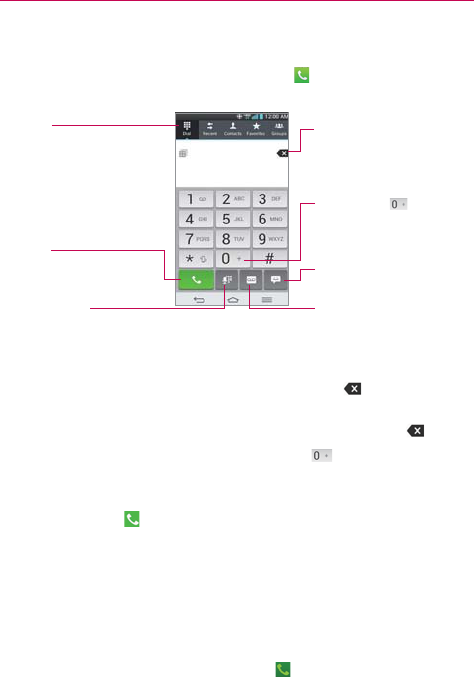
58 Calls
To place a call by dialing
1. From the Home screen, tap the Phone Key in the Quick Key bar to
open the Dial tab of the Phone application.
Touch and hold to enter
the plus ( + ) symbol to dial an
international number.
Delete Key
Tap here to delete incorrect
number(s) (appears after you
begin entering numbers).
Call Key
Tap here to dial the number that
you entered manually.
Dial Tab
Displays the diapad.
Voice Dialer Key
Tap here to dial by saying the
number.
Message Key
Tap here to send a message to
the number that you entered.
Voicemail Key
Tap here to access your
voicemail feature.
2. Enter the number you want to call on the dialpad.
If you enter a wrong number, tap the Delete Key to erase digits
one by one.
To erase the entire number, touch and hold the Delete Key .
To dial an international number, touch and hold to enter the plus ( + )
symbol. Then enter the international prefix for the country, followed by the
full phone number.
3. Tap the Call Key to dial the number that you entered.
Press the Volume Keys on the back of the phone to adjust the call
volume.
Use the on-screen buttons to enter additional numbers, place the call
on hold and take an incoming call, add another call, use the
speakerphone, end the call, and other options.
You can use other phone features while the call is underway. If you
open another application, the Call icon appears in the Status Bar for
the duration of the call.

59
Calls
NOTE If you opened other applications while on a call, you'll need to return to the Call screen to
end the call. To return to the Call screen, you can tap the Home Key (in the Front
Touch Keys bar), then tap the Phone Key (in the Quick Keys bar), or drag the
Notifications panel down and tap the Call icon . You can also tap the Contact's name or
number at the top right corner of the Home screen.
To end a call
Simply tap the End button on the Call screen to end the call.
If you accessed other device functions while the call was in progress, there
are several ways to return to the Call screen to end the call.
Tap the Home Key (in the Front Touch Keys bar), tap the Phone
Key (in the Quick Keys bar), then tap the End button on the Call
screen.
Tap the Home Key (in the Front Touch Keys bar), tap the Contact’s
name or number at the top right corner of the Home screen, then tap
the End button on the Call screen.
Drag the Notifications panel down, then tap the End button on the
Call screen.
NOTE You can also press the Power/Lock Key on the back of the phone to end the call, if
you activated this feature in the Call settings menu.
Speed dialing
If you set up Speed dials in the Contacts application, you can dial a number
by simply touching and holding the Speed dial number on the dialpad.
Tap the Phone button (in the Quick Keys bar), then touch and hold
the Speed dial number.
Direct dialing
If you placed a Direct dial widget on your Home screen, simply tap the
Direct dial widget to call that number.
To set a Direct dial widget to your Home screen
1. Touch and hold an empty area on your Home screen.
2. Tap the Widgets tab > Direct dial.
3. Tap the contact in your Contacts list.
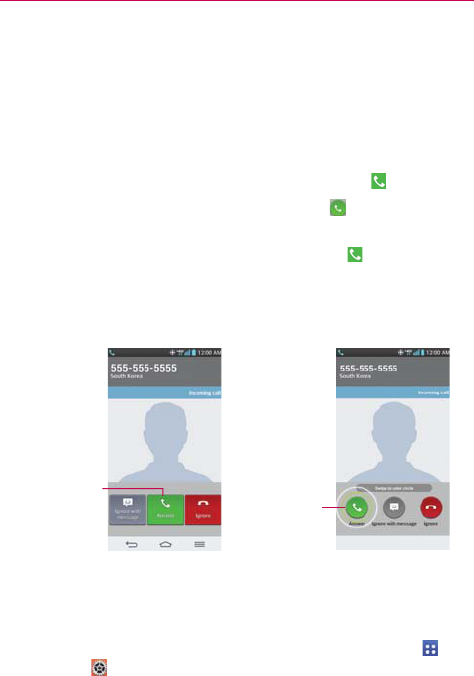
60 Calls
Answering or Rejecting Calls
When you receive a phone call, the Incoming call screen opens with the
caller ID and any additional information about the caller that you have saved
in the Contacts list. All incoming calls are recorded in the Recent tab.
To answer a call
If the screen is unlocked, simply tap the Answer Key .
If the screen is locked, swipe the Answer icon in any direction to
answer the call.
If you were already on a call, tap the Answer Key to place the first
call on hold while you answer the new call.
NOTE To silence the incoming call ringer, press either of the Volume Keys on the back of the
phone.
Swipe the Answer
icon in any direction
to answer the call.
Unlocked Screen Locked Screen
Tap the Answer Key
to answer the call.
To use the Answer Me feature
The Answer Me feature allows you to bring the phone to your ear to
answer an incoming call automatically.
To activate the feature, from the Home screen, tap Apps Key >
Settings > Gestures > tap the Answer Me checkbox.
During an incoming call, bring the phone up to your ear to answer the
call.
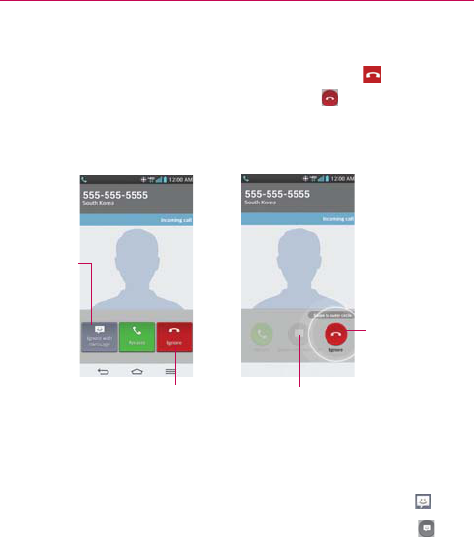
61
Calls
To ignore a call and divert it to voicemail
If the screen is unlocked, simply tap the Ignore Key .
If the screen is locked, swipe the Ignore icon in any direction to
ignore the call.
The caller is sent directly to your voicemail box to leave a message.
Tap the Ignore
with message
Key to send a
quick message
to the caller
and forward
them to your
voicemail.
Unlocked Screen Locked Screen
Tap the Ignore Key to ignore
the call and send the caller
directly to your voicemail box
to leave a message.
Swipe the Ignore with message icon in
any direction to send a quick message to
the caller and forward them to your
voicemail.
Swipe the Ignore
icon in any direction
to Ignore the call.
NOTE To silence the ringer, press either of the Volume Keys on the back of the phone.
To ignore a call and send a text message
If the screen is unlocked, tap the Ignore with message Key .
If the screen is locked, swipe the Ignore with message icon in
any direction.
Tap the text message you want to send in place of answering the call.
NOTE This feature can only be used to send a message to another mobile phone. It is not
applicable to incoming landline calls.
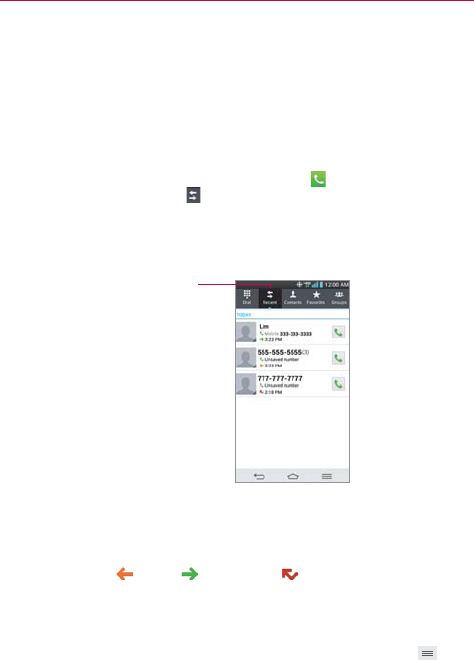
62 Calls
Working With the Recent tab
The Recent tab records all of the calls you’ve dialed, received, or missed. It
offers a convenient way to redial a number, return a call, or add a number to
your Contacts.
To open the Recent tab
From the Home screen, tap the Phone Key (in the Quick Keys bar),
then tap the Recent tab at the top of the screen.
The Recent tab lists your calls chronologically by phone number. The
number in parenthesis indicates the number of calls recorded for that
phone number.
The Recent tab
displays the history of
all of your calls.
Viewing call entries
Open the Recent tab, then tap an entry to view all of the entries for that
phone number. Calls are listed chronologically and each one includes the
call type (received , dialed , and missed ), the date, and the time of
the call.
Filtering your list of calls
To view a specific call list, from the Recent tab, tap the Menu Key (in
the Front Touch Keys bar), then tap Filter. Select the call type you want to
view.

63
Calls
Tap the Back Key (in the Front Touch Keys bar) to return to the Recent
tab screen.
To dial a number in the Recent tab
From the Recent tab, tap the Call Key at the right of the call entry.
From the Recent tab, tap the image to the left of the entry to view all
of the contact's numbers saved in your phone’s memory. Tap a phone
number to dial it.
TIP You can edit a phone number in the Recent tab before you place the call (e.g., to insert
an area code when you are traveling). Touch and hold the entry, then tap Edit number
before call in the Context menu. Edit the number as necessary, then tap the Call Key
.
To add a number from the Recent tab to your Contacts
1. Touch and hold the call entry in the Recent tab.
2. Tap Add to Contacts in the Context menu.
3. Tap New contact or Update contact and save it as necessary.
Clearing your Recent calls
You can delete the entire list of Recent calls at once or selectively delete
entries.
1. Open the Recent tab.
2. Tap the Menu Key (in the Front Touch Keys bar).
Tap Clear to select entries to remove from the list. Checkmark the
entries to delete, tap Clear, then Yes.
Tap Clear all to remove all of the entries from the list. Tap Ye s to
confirm you want to clear the entire list.
NOTE You can also select a specific number to be deleted. Touch and hold an entry in the
Recent list to open the Context menu. Tap Clear all logs of this number, then tap Ye s
to confirm.

64 Calls
Calling Your Contacts
Instead of manually dialing phone numbers using the dialpad, you can use
your Contacts list to dial quickly and easily. You can also quickly call a
contact using Quick Contact or Direct dial icons that you placed on your
Home screen.
If you have contacts on the web, they’re synchronized with your phone
when you first synchronize with your Google™ Account.
To call a contact
1. From the Home screen, tap the Contacts Key (in the Quick Keys bar).
2. Tap the contact you want to call.
3. Tap the contact’s phone number you want to call.
To call a favorite contact
1. From the Home screen, tap the Contacts Key (in the Quick Keys bar),
then tap the Favorites tab at the top of the screen.
2. Tap the contact you want to call.
3. Tap the contact’s phone number you want to call.
Instant List
Instant list is displayed on the Dial tab to help you use the information
stored in your phone without needing to search for it first. Once you enter
three or more numbers, Instant list displays entries from your Contacts list
or Recent calls that match the sequence you entered.
Sequence matches
Your phone searches for the entered sequence anywhere in the number;
beginning, end, or anywhere in-between. The matching number sequence
is displayed within the number in blue text. The name and type of number
(i.e., Mobile, Work, etc.) associated with the number you entered is
displayed above the dialpad. When there are multiple matches, the Instant
list displays the number of matches in your phone's memory. Tap the
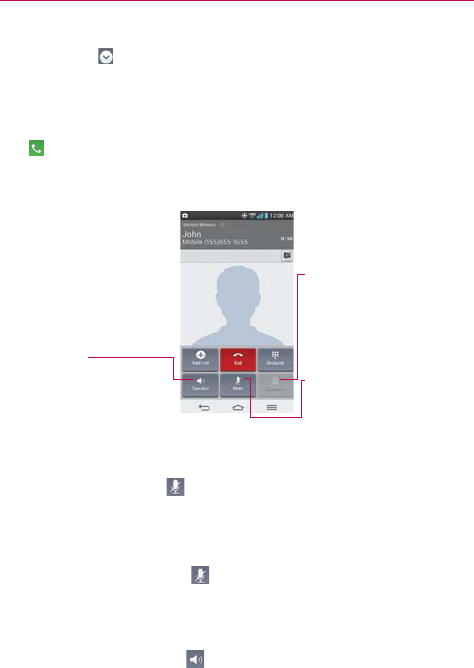
65
Calls
Instant list icon on the right side of the screen to view the entire list of
matching entries. Tap the Cancel button to close the list.
Selecting an Instant list entry
Tap an entry in the Instant list to insert it on the dialpad and tap the Call
Key to dial it.
Options During a Call
Bluetooth Button
Tap here to switch between a
Bluetooth device and the phone.
The light bar illuminates to indicate
that the call is using a Bluetooth
device. The button is greyed out
when there is no Bluetooth device
available.
Mute Button
Tap here to mute the microphone
during a call. The light bar
illuminates when the microphone
is muted.
Speaker Button
Tap here to turn the speakerphone
on or off. The light bar illuminates
when it's on.
To mute the microphone
Tap the Mute button on the Call screen.
The light bar on the Mute button illuminates to indicate that the
microphone is muted.
When viewing the Call screen, you can unmute the microphone by
tapping the Mute button again.
The microphone is unmuted automatically when the call ends.
To turn the speakerphone on or off
Tap the Speaker button on the Call screen.
The light bar on the Speaker button illuminates to indicate that the
speakerphone is on.

66 Calls
When viewing the Call screen, you can turn the speakerphone off by
tapping the Speaker button again.
The speaker is turned off automatically when the call ends.
WARNING!
To avoid damage to your hearing, do not hold the phone against your ear when the
speakerphone is turned on.
To switch between a Bluetooth headset and the phone
When a Bluetooth headset is paired and connected to your phone, you can
conduct calls on the headset for hands-free conversation. During a call, you
can opt to use the Bluetooth headset or just the phone.
When using the Bluetooth headset during a call, the Ongoing Call
notification icon is blue in the Status Bar (the icon is green when using the
phone).
Tap the Bluetooth button on the call screen to switch the call from
the phone to the Bluetooth device, or vice versa.
Managing Multiple Calls
Contact your wireless service provider to find out which call services are
supported.
To switch between current calls
Tap Swap calls .
The current call will be placed on hold and you will be connected with
the other call.
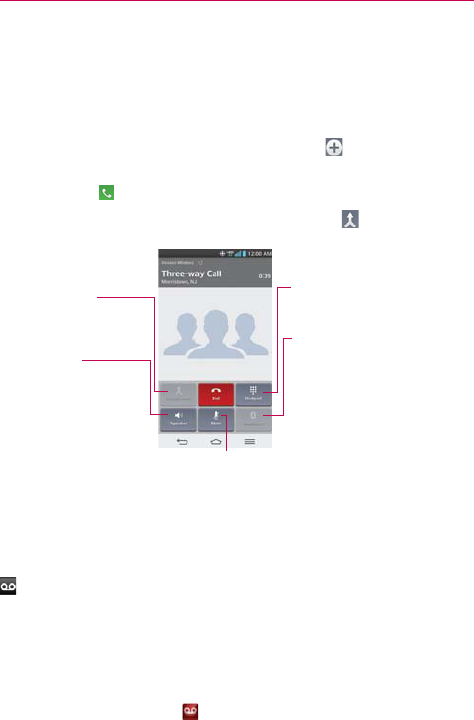
67
Calls
To set up a conference call
Contact your wireless service provider to find out whether they support
conference calls and how many participants you can include.
1. Place a call to the first participant.
2. When you’re connected, tap the Add call button on the Call screen.
3. Use the keys on the dialpad to manually enter a phone number, then tap
the Call Key .
4. After you’re connected, tap the Merge calls button . The participant is
added to the conference call.
Merge Calls Button
Tap here to merge the separate
calls into a conference call.
Speaker Button
Tap here to turn the
speakerphone on (or off). The
light bar illuminates when the
speakerphone is on.
Dialpad Button
Tap here to dial another number to
participate in the conference call.
Bluetooth Button
Tap here to switch between a
Bluetooth device and the phone. The
light bar illuminates to indicate that
the call is using a Bluetooth device.
The button is greyed out when there
is no Bluetooth device available.
Mute Button
Tap here to mute the microphone during a call.
The light bar illuminates when the microphone is
muted.
Listening to Your Voicemail
When you have a new voicemail message, the Voicemail notification icon
appears in the Status Bar. If you have not set up your voicemail number,
or if you need to change it, you can do that in the Call settings.
To listen to your Voicemail
Open the Notifications panel and tap New voicemail.
OR
Tap the Voicemail icon on the Home screen.

68 Calls
OR
From the Home screen, tap the Phone Key in the Quick Keys bar,
then tap the Voicemail Key . Typically, your carrier’s voicemail
system guides you through the process of listening to and managing
your voicemail. The first time you call your voicemail, it also guides
you through the process of recording greetings, setting a password,
etc.
To set up your Voicemail
1. From the Home screen, tap the Phone Key in the Quick Keys bar.
(The Phone application can also be accessed from the Applications
screen.)
2. Tap the Voicemail Key to dial your voice mailbox.
3. Follow the setup tutorial.
4. Enter a password.
5. Record a voice signature and greetings for your voice mailbox.
Airplane mode
Some locations may require you to turn off your phone’s wireless connections
by placing your phone in Airplane mode.
1. Press and hold the Power/Lock Key on the back of the phone.
2. Tap Turn on Airplane mode in the dialog box that appears.
NOTE The Wireless & networks settings menu also has a switch to enable or disable Airplane
mode. Airplane mode can also be toggled on or off in the Quick settings on the
Notifications panel.
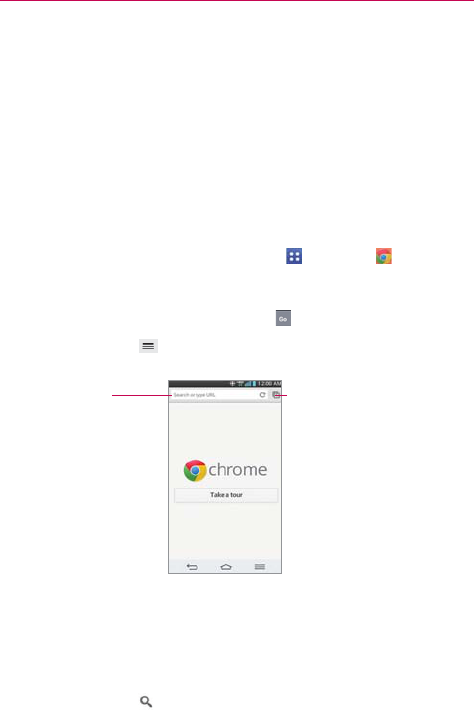
69
Web
Chrome
The Chrome application allows you to access the internet from your
device. Access and selections within this feature are dependent upon your
service provider. For specific information on internet access through your
phone, contact your service provider.
NOTES s You may incur additional charges for accessing the web and downloading media. For
details, contact your service provider.
s Chrome may differ from this user guide due to updates via Play Store.
Browse web pages
1. From the Home screen, tap the Apps Key > Chrome or tap the
Chrome icon on the Home screen.
2. Tap the URL input field to access a specific web page. Enter the web
address (URL) of the web page, then tap on the on-screen keyboard.
3. Tap the Menu Key (in the Front Touch Keys bar) to access Chrome
options.
URL Input Field
(address bar)
Tap here to enter a web
address for the web page
you want to access.
Open Tabs Icon
Tap here to view your open
webpage tabs.
Search the web
When you begin entering text in the URL input field at the access the
screen to search the web or type in a web address, suggestions appear
below the address bar. Each address suggestion displays one of the
following icons:
The Search icon appears next to searches.

70 Web
The Bookmark icon appears next to bookmarked sites.
The History icon appears next to sites from your browsing history.
The Globe icon appears next to related sites.
You can set the default search engine for the address bar by tapping
the Menu Key (in the Front Touch Keys bar) > Settings > Search
engine.
Search within a webpage
1. Tap the Menu Key (in the Front Touch Keys bar), then tap Find in
page.
2. Type the text you’re looking for in the find bar at the top of the screen.
Matches are highlighted on the page (exact matches in orange and
partial matches in yellow).
The find bar displays the total number of matches. Tap the up and
down arrows to the right of the find bar to go to each match.
Found matches are also indicated in the scroll column along the right
side of the screen. Tap any of the highlights to jump directly to that
match.
Sign in to Chrome
When you sign in to Chrome with your Google Account, you can take
advantage of several time-saving services:
Sync lets you access your Chrome bookmarks, browsing history, and
open tabs from other devices where you’re also signed in.
Chrome to Mobile lets you send webpages from your computer to
your mobile device with one click.
Auto sign-in helps you sign in to Google services with a touch of a
button. No need to type your username and password.
To sign in, open Chrome and tap the Menu Key > Settings > SIGN IN
TO CHROME (at the bottom of the screen).

71
Web
Browse with tabs
Your device displays webpages in a tab format allowing you to browse
several webpages simultaneously. Create multiple tabs for the sites you
want, then tap the Open tabs icon (in the upper-right corner of the
screen) to quickly and easily access them.
Create a new tab
From the Chrome application, tap the Menu Key (in the Front Touch
Keys bar), then tap New tab.
The New Tab page
The following options are available when you create a new tab. These
options, located at the bottom of the screen, help you open the page that
you want quickly.
Most Visited Snapshots of the webpages that you visit the most
are shown here. Just tap a snapshot to visit the site using the new
tab you created. Touch and hold a snapshot to open a Context menu
to access Open in new tab, Open in incognito tab, or Remove.
Bookmarks Icons for sites that you’ve bookmarked are listed here.
Tap a bookmark icon to visit the site using the new tab you created.
Touch and hold a bookmark to open a Context menu to access Open
in new tab, Open in incognito tab, Edit bookmark, Delete
bookmark or Add to home screen.
Other devices Chrome tabs that are opened on other devices are
shown here. Tap a page icon to open the same tab on your device.
You must be signed in to Chrome to sync your open tabs across
devices.
NOTE When you edit items in the Most Visited and Bookmarks options, it can take up to 15
seconds for open tabs to refresh on other devices.

72 Web
Working with tabs
Open an Incognito tab (browse in private)
From the Chrome application, tap the Menu Key (in the Front Touch
Keys bar), then tap New incognito tab. When browsing in incognito mode,
your browsing history, cookies, and cache are automatically cleared once
you’ve closed all of your incognito tabs. You still have access to your usual
bookmarks and omnibox predictions. Changes that you’ve made to your
bookmarks are saved.
Switch in and out of Incognito mode
1. From the Chrome application, tap the Open tabs icon at the top right
of the screen.
2. Drag from right to left to bring Incognito tabs to the front.
Drag from left to right to return to your standard tabs.
Switch to another tab
1. From the Chrome application, tap the Open tabs icon at the top right
of the screen.
2. Scroll up or down (the tabs are stacked vertically), then tap the tab that
you want to switch to.
You can also swipe to switch tabs. While viewing an open tab:
Swipe from the right-hand edge of the screen to the left to go to the
next tab in the list.
Swipe from the left-hand edge of the screen to the right to go to the
previous tab in the list.
Close your tabs
Close a single tab: Tap the Open tabs icon then tap the X in the
upper right-hand corner of the tab that you want to close. Or swipe
the tab to the left or right off of the screen to close it.

73
Web
Close all tabs: Tap the Open tabs icon , then tap the Menu Key
in the Front Touch Keys bar), then tap Close all tabs.
Download files
1. Touch and hold a download link.
2. In the Context menu that appears, tap Save link.
To view downloaded files:
From the Applications screen (or the Home screen), tap the Downloads
icon .
To open a downloaded file, tap it.
To view earlier downloads, tap the heading date you want to view.
To share downloads, tap the Share icon at the top of the screen,
checkmark the ones to share, then tap Share and choose a sharing
method from the list.
To delete downloads, tap the Delete icon at the top of the screen,
checkmark the ones to delete, tap Delete, then Yes to confirm.
Tap Size or Date, at the top left of the screen, to switch the download
file sort criteria.
Using bookmarks
Bookmarks let you revisit your favorite webpages with one touch.
Create a bookmark
1. While viewing the page you want to set as a Favorite, tap the Menu Key
(in the Front Touch Keys bar), then tap the Favorites icon at the
top of the Options menu.
2. Edit the bookmark’s name and address, if necessary.
3. By default it will be saved to your mobile bookmarks folder. Tap the In
field to change the location (or create a new folder for it).
4. Tap Save to save the bookmark.

74 Web
Open a bookmark
1. From the Chrome application, tap the Menu Key (in the Front Touch
Keys bar), then tap Bookmarks (or open a new tab and tap at the
bottom of the screen).
2. Tap the bookmark you want to visit.
NOTE If you don't see the bookmark, tap the folder you saved it in, or tap the filepath to go to
the location where it was saved.
Edit or delete bookmark
1. From the Chrome application, tap the Menu Key (in the Front Touch
Keys bar), then tap Bookmarks (or open a new tab and tap at the
bottom of the screen).
2. Touch and hold the bookmark you want to edit or delete.
Tap Edit bookmark. Once you’re finished editing, tap Save.
Tap Delete bookmark.
TIP Sign in to Chrome to sync your bookmarks to your Google Account. Then you can
access them from any device.
Add a bookmark to your Home screen
Save time by adding bookmarks you use frequently to your Home screen
as shortcuts.
1. From the Chrome application, tap the Menu Key (in the Front Touch
Keys bar), then tap Bookmarks (or open a new tab and tap at the
bottom of the screen).
2. Touch and hold the bookmark until a Context menu appears.
3. Tap Add to home screen.
Chrome Settings
To access the settings specific to the Chrome application:
1. From the Chrome application, tap the Menu Key (in the Front Touch
Keys bar).
2. Tap Settings.

75
Web
3. Tap the setting you want.
BASICS
Search engine
Sets your default search engine for searching the internet.
1. From the Chrome application, tap the Menu Key (in the Front Touch
Keys bar) > Settings > Search engine.
2. Tap the search engine you want to use.
Autofill forms
Use the autofill feature to fill in web forms with a single tap.
Enable or disable autofill
1. From the Chrome application, tap the Menu Key (in the Front Touch
Keys bar) > Settings > Autofill forms.
2. Tap the Autofill forms switch at the top of the screen to toggle it
On (blue) or Off (grey).
Manage your autofill entries
From the Chrome application, tap the Menu Key (in the Front Touch
Keys bar) > Settings > Autofill forms.
Tap Add profile to add your personal information such as company,
address, etc.
Tap Add credit card to add a new credit card.
Edit an entry by tapping the profile in the list. Tap Save at the bottom
of the screen when you’ve finished updating.
Delete an entry by tapping the profile in the list. Tap Delete at the
bottom of the screen to remove the entry.
NOTE Access the Privacy setting to clear your autofill entries.
Save passwords
You can let Chrome remember your passwords for the sites you use.

76 Web
Enable or disable saving passwords
1. From the Chrome application, tap the Menu Key (in the Front Touch
Keys bar) > Settings > Save passwords.
2. Tap the Save passwords switch at the top of the screen to
toggle it On (blue) or Off (grey).
Manage password prompts
If you enable Chrome to save your passwords, you’ll get a prompt every
time when you sign in to a new website.
Tap Yes if you want Chrome to remember your sign-in credentials for
that site. Chrome will automatically complete the sign-in fields for you
when you visit the website again.
Tap Never if you don’t want Chrome to save your username and
password for the website you’re on.
Change password setting sites
1. From the Chrome application, tap the Menu Key (in the Front Touch
Keys bar) > Settings > Save passwords.
2. Tap the site that you want to remove from the list.
Tap a site in the Saved Passwords list to move it to the Never saved
list.
Tap a site in the Never saved list to move it to the Saved Passwords
list.
3. Tap Delete.
ADVANCED
Privacy
Set your search privacy settings
1. From the Chrome application, tap the Menu Key (in the Front Touch
Keys bar) > Settings > Privacy.
2. Configure your privacy settings as necessary.

77
Web
Clear your browsing data
1. From the Chrome application, tap the Menu Key (in the Front Touch
Keys bar) > Settings > Privacy.
2. Tap CLEAR BROWSING DATA at the bottom of the screen.
3. Checkmark the items you want to clear, then tap Clear.
Accessibility
Adjust text size on webpages
1. From the Chrome application, tap the Menu Key (in the Front Touch
Keys bar) > Settings > Accessibility.
2. Drag the Text scaling slider along the bar to adjust the text size scaling.
The Preview box displays how it will appear on webpages.
Force enable zoom
1. From the Chrome application, tap the Menu Key (in the Front Touch
Keys bar) > Settings > Accessibility.
2. Checkmark the Force enable zoom checkbox to override a site's zoom
functionality and allow zooming in or out.
Manage content settings
Adjust the type of content that websites can show and the information
they can use to enhance your web experience.
1. From the Chrome application, tap the Menu Key (in the Front Touch
Keys bar) > Settings.
2. Tap Content settings.
Accept cookies Checkmark to enable websites to store small files on
your device in order to save your preferences on websites or keep
you signed in. Remove the checkmark to prevent webpages from
storing cookies on your mobile device.
Enable JavaScript Checkmark to enable JavaScript. Many web
developers use JavaScript to make their websites more interactive.

78 Web
Sites may function correctly only if they can run JavaScript on your
mobile device.
Block pop-ups Checkmark to prevent websites from showing
additional windows automatically.
Google location settings Tap this option to set your location access
used by websites.
Website settings Tap this option to clear location permissions or local
data stored on your device for a specific site.
Preload webpages
Chrome helps you open webpages faster by predicting where you might go
next on the page. The browser preloads the page’s data in the background,
so the page can open immediately if you tap its link. Keep in mind this
feature may use a large amount of data on your mobile device. But you can
always control when Chrome uses this feature:
1. From the Chrome application, tap the Menu Key (in the Front Touch
Keys bar) > Settings > Bandwidth management.
2. Tap Preload webpages.
3. Select an option:
Always: Chrome will preload webpages no matter how you are
connected (e.g., mobile data, Wi-Fi, etc.).
Only on Wi-Fi: Chrome will preload webpages only if you’re not using
mobile data.
Never: Chrome won’t preload webpages.

79
Communication
Contacts
The Contacts application allows you to store names, phone numbers, and
other information in your phone’s memory. Entries are listed alphabetically.
You can scroll through the list, or tap the Favorites tab or Groups tab at the
top of the screen.
Use the Contacts application to add, view, and communicate with your
friends, acquaintances, and associates.
To open your Contacts application
From the Home screen, tap the Apps Key
> Contacts
.
OR
Tap the Home Key (in the Front Touch Keys bar) > the Contacts
Key (in the Quick Keys bar).
If you have a new phone and haven’t added any contacts yet, the
Contacts application will display hints on how to start adding contacts to
your phone.
Contacts list
When you open the Contacts application, your contacts list is displayed.
The alphabet is displayed vertically along the right side of the screen with a
blue bar that indicates where you are in the list.
In case of Emergency (ICE) is displayed above your list of contacts. Add up
to 5 ICE entries from your contacts list. These are entries that someone can
contact on your behalf in the event of an emergency, whether or not the
phone is locked.
To add ICE entries
1. From the Home screen, tap the
Contacts
(in the Quick Keys bar).
2. Tap In case of Emergency at the top of the screen.
3. Tap the Add entry icon in the lower left corner of the screen.
4. Checkmark the entry (or entries) to add to your ICE list, then tap Done.

80 Communication
ICE Information
In addition to your ICE contacts, you can enter personal information about
you (such as medical record number, allergies, medications, special
instructions, etc.) that can be accessed in case of an emergency. To add
your personal information:
1. From the ICE screen, tap the Information icon at the bottom center
of the screen.
2. Tap , enter your information, then tap Save.
To search for a contact
1. From the Home screen, tap the
Apps Key
> Contacts
.
2. Tap the Search contacts field and enter the contact name using the
keyboard.
Searching your online contacts simultaneously
You can search for your contacts simultaneously from all of your online
accounts.
To set your device to search simultaneously, from the Contacts application,
tap the Menu Key (in the Front Touch Keys bar) > Settings >
checkmark the Online search checkbox.
To open a list of your favorite contacts
Open your Contacts application and tap the Favorites tab at the
top of the screen.
Favorites lists the contacts you’ve designated as Favorites (at the top
of the screen) and Contacts you’ve contacted frequently (at the
bottom of the screen). While viewing the Favorites tab, tap the Menu
Key (in the Front Touch Keys bar) to change the display from grid
view to list view.
To open your groups list
Open the Contacts application and tap the Groups tab at the top
of the screen.
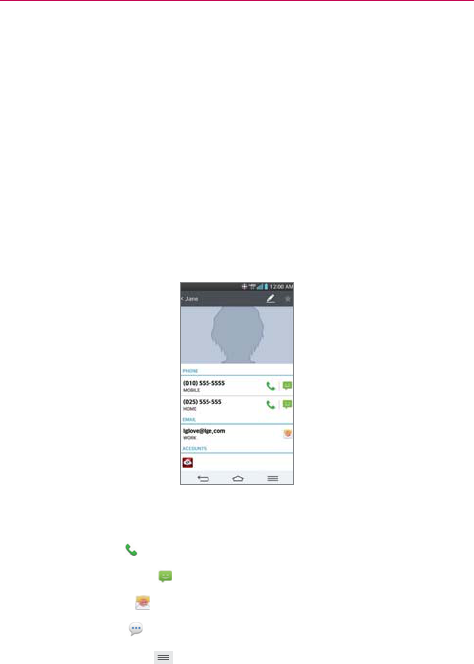
81
Communication
Groups displays your contacts by category (at the top of the screen)
and your accounts (at the bottom of the screen).
Resizing the entries
While viewing your Contacts (contacts list, favorites list, or groups), place
two fingers on the screen, then spread them apart to increase the size of
the entries for easier viewing. Pinch in to decrease the size and see more
entries on the screen.
To view details about a contact
1. Open your Contacts application.
2. Tap the contact whose details you want to view.
3. The Contact’s information will be displayed. The following options are
available.
The Dial icon places a call to the number.
The Message icon starts a message.
The Email icon starts an email.
The Chat icon starts a chat.
Tap the Menu Key
(in the Front Touch Keys bar) to access the
following menu options: Delete, Share, Join, Separate, Set as
default, Export, Add to Home screen, and All calls to voicemail.

82 Communication
Adding Contacts
You can add contacts on your phone and synchronize them with the
contacts in your Google™ Account, Microsoft Exchange account, or other
accounts that support syncing contacts.
Since your contacts can come from a variety of sources, the Contacts
application attempts to join new information with existing similar contact
entries, to create a single entry. You can also manage that process manually
by joining or splitting entries.
To add a new contact
1. Open the Contacts application.
2. Tap the New contact icon to the right of the search box.
3. If you have more than one account with contacts, select the account
where you want to save the contact.
NOTE To change the account later, edit the entry, tap at the top of the screen, then tap the
account you want it assigned to.
4. Enter the contact’s name.
5. Tap a category of contact information, such as phone number or email
address, to enter that kind of information about your contact.
6. Tap a category’s Add new icon to add more than one entry for that
category. For example, in the phone number category, enter a work
number and add a home number. Tap the label field to the right of the
entered information to open a drop-down menu of preset labels. For
example, HOME or WORK for a phone number.
7. Tap the Picture frame icon to select a picture to display next to the
name in your list of contacts and in other applications.
8. Tap Add another field at the bottom of the screen to add additional
fields including Organization, IM, Notes, Nickname, Website, Events,
and Relationship.
NOTE You can also set the color of the notification LED for the contact.
9. When you’re finished, tap Save.

83
Communication
Editing a Contacts entry
1. Open the Contacts application and tap the contact entry you want to
edit.
2. Tap the Edit icon at the top of the screen.
3. Edit the entry as needed, then tap Save at the bottom of the screen.
Setting the default phone number
When you save more than one phone number in a contact entry, you can
set one of them as the default number.
1. Open the Contacts application and tap the contact entry you want.
2. Touch and hold the number you want to set as the default number.
3. Tap Set as default number in the context menu that appears. A red
checkmark indicates the default number.
Favorites Contacts
The Favorites tab contains a short list of the contacts you communicate
with most often.
Adding or removing contacts in your Favorites list
1. Open the Contacts application, then tap a contact to view its details.
2. Tap the star in the upper-right corner of the screen.
A gold-colored star indicates a Favorite.
A grey-colored star indicates a normal contact.
Contacts Options menu
From the Contacts application, tap the
Menu Key
(in the Front Touch
Keys bar) to access the Options menus:
Contacts tab: Backup now, Delete, Share, Send message, Send
email, Speed dial, Join Contacts, Import/Export, Edit tabs, Settings,
and Help.

84 Communication
Favorites tab: Add favorites, Remove favorites, Share, Send
message, Send email, List/Grid view, Edit tabs, and Settings.
Groups tab: New group, Delete, Share, Change order, Edit tabs, and
Settings.
Joining and separating contacts
When you have two or more entries for the same contact, you can join
them into a single entry. You can also separate contacts that were joined.
1. Open the Contacts application, then tap the
Menu Key
(in the Front
Touch Keys bar).
2. Tap Join contacts.
3. Select a tab at the top of the screen.
Tap Join suggestion to select entries to merge.
Tap Joined contacts to select entries to separate.
4. Checkmark the entry (or entries) you want, then tap Join or Separate.
Setting Speed Dial
1. Open the Contacts application.
2. Tap the
Menu Key
(in the Front Touch Keys bar).
3. Tap Speed dial.
4. Tap the speed dial number to assign.
5. Tap the Contact entry.
NOTE If the entry includes multiple numbers, make sure you tap the number you want set to
that speed dial.
Transfer type
When you want to send your contacts entries, you can combine them all
into one file, or you can send separate vCard files.
To set the transfer type, from the Contacts application, tap the
Menu Key
(in the Front Touch Keys bar) > Settings > Transfer type.

85
Communication
Send as one file - This setting combines all of your contacts into one
file. It allows a faster transfer, but some devices can't receive contact
information sent using this option.
Send separately - This setting sends each contact as a separate
vCard file. It allows all devices to receive your files.
Communicating With Your Contacts
The Contacts application shares information with many other applications
allowing you to quickly and easily initiate communication with your saved
entries.
General communication
1. Tap a contact to view the entry details (from Contacts, Favorites,
Groups, or Recent).
2. Tap the icon corresponding to the type of communication you want to
start.
The Dial icon places a call to the number.
The Message icon starts a message.
The Email icon starts an email.
The Chat icon starts a chat.
NOTE The communication icons displayed depend on the types of information you have saved
for the contact.
Quick Contact for Android™
1. Tap a contact to view the entry details (from Contacts, Favorites,
Groups, or Recent).
2. Tap the contact’s picture on the left side of the entry to display the Quick
Contact icons.
3. Tap the icon corresponding to the type of communication you want to
start.

86 Communication
Messaging
To open the Messaging application
From the Home screen, tap the Messaging Key in the Quick Keys
bar.
Using the Messaging application
Tap the New message icon to start a new text or multimedia
message.
Tap here to create a new message.
Tap an existing message thread to open it.
NOTE Pinch in (or spread apart) on your list of messages to resize it for easier viewing or
navigation.
To delete a message thread from the Messaging window
1. Touch and hold the message thread.
2. Tap Delete in the Context menu that opens.
3. Tap Ye s to confirm you want to delete the message thread.
To send a text message
1. On the Messaging screen, tap the New message icon in the
upper-right corner of the screen.
2. Enter a mobile phone number (or a name saved in your Contacts) in the
To field.
As you enter the numbers or characters, matching Contacts entry
name(s) and number(s) appear. The match can be anywhere in the entry.
You can tap a suggested recipient to insert it in the To field, or continue
entering the phone number.
3. Tap the text field to start entering your message.
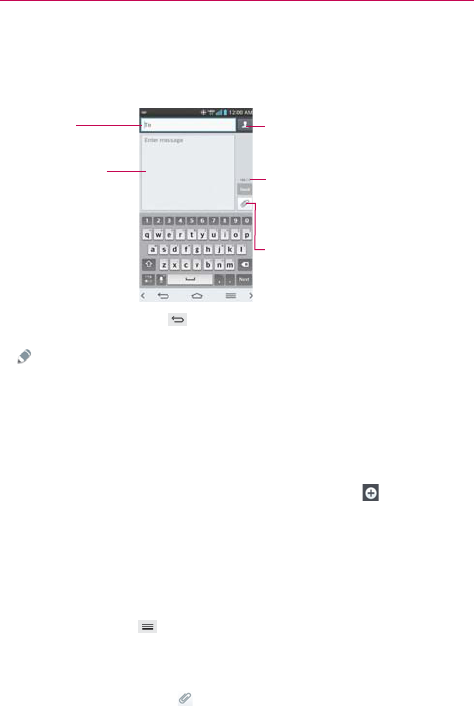
87
Communication
A character counter is displayed to the right of the message field to let
you know how many more characters you can type and also the number
of pages in the message.
Contacts icon
Tap here to enter the recipient(s) by
selecting from entries in your
Contacts.
To field
Tap here to enter the
recipient(s) manually.
Message field
Tap here to enter
your message.
Attachment icon
Tap here to add an attachment to
your message.
Character counter
Displays the number of characters
entered and the amount remaining.
If you tap the Back Key (in the Front Touch Keys bar) while
composing a message, it’s automatically saved as a draft. The Draft icon
on the right side of the message thread indicates a pending draft
message to the recipient. Tap the message to resume composing it.
4. Tap the Send button to send the message.
Your message is displayed and responses appear in the same window,
creating a message thread with that contact.
To create and send a multimedia message
1. On the Messaging screen, tap the New message icon at the top
right corner of the screen.
2. Enter a mobile phone number, email address, or Contact name in the To
field. As you type, matching contacts appear. You can tap a suggested
contact or continue typing.
3. Tap the text field to start entering your message.
4. Tap the Menu Key (in the Front Touch Keys bar) > Add subject to
add a message subject.
The subject text appears above the body text in bold letters.
5. Tap the Attachment icon to open a dialog box where you can choose
the type of media file to attach to the message.

88 Communication
Tap Picture to select a picture from your Gallery.
Tap Take photo to take a photo and attach it.
Tap Video to select a video from your Gallery.
Tap Record video to record a video and attach it.
Tap Audio to select an audio file.
Tap Record voice to record an audio message and attach it.
Tap Location to select a map location to send.
Tap Contact to select either vCard or text to attach.
Tap Memo to select a memo and insert it.
Tap Slide to assemble photos, audio file(s), videos, texts into a slide
(up to 10 slides) to attach to the message.
NOTE To delete an attachment, simply tap the Delete icon on the attached file.
6. Tap the Send MMS button to send the message.
To send a group message
1. On the Messaging screen, tap the New message icon in the upper
right corner of the screen.
2. Add the recipients.
3. Select how the message will be sent, by Group Conversation or
Individual Messages.
Tap the Group Conversation button to allow all of the recipients to
be viewed by each other so they can respond to you and the group.
The message is sent as a multimedia message (MMS).
Tap the Individual Messages button so that none of the recipients
can see the other recipients (similar to BCC). Each individual can only
respond to your message.
NOTE Tap the Help icon to view information regarding using these buttons.
4. Complete the message as necessary, then tap the Send to all button.

89
Communication
Using Direct message
If you placed a Direct message widget on your Home screen, simply tap
the contact’s Direct message widget to automatically start a message to
that contact.
Receiving and viewing messages
If you’re working in a message window, messages that you receive from
that contact are displayed. Otherwise, you receive a new message
notification and a new message icon appears in the Status Bar. When
you tap the new message notification, the Message screen opens where
you can reply to the message. If the New message pop-up setting is
activated, you will receive a pop-up notification on the current screen where
you can directly reply from.
Tap the Download button at the bottom of the screen if the Auto-retrieve
setting is not checkmarked.
If the message contains a media file, tap the Play button to view, watch, or
listen to it. Touch and hold the media file to open a Context menu with
additional options.
To respond to messages you receive
While viewing the received message, tap the text field at the bottom of the
screen, complete your response as necessary, then tap the Send button.
Changing Messaging Settings
To change the Messaging settings, open the Messaging application,
tap the Menu Key (in the Front Touch Keys bar) > Settings.
Storage
Delete old messages: Checkmark this setting to allow the phone to delete
older messages in a thread when the Text message limit or Multimedia
message limit is reached. Uncheckmark this setting to keep all messages.
Text message limit: Tap to set the number of text messages to save per
thread.

90 Communication
Multimedia message limit: Tap to set the number of multimedia
messages to save per thread.
Signature: Checkmark this setting to automatically add a signature that you
set.
Callback number: Checkmark this setting to automatically enter a callback
number. The default is the phone number, but you can change it to another
number.
Text message
Delivery reports: Checkmark this setting to allow your phone to receive
delivery reports for the messages you send.
Manage SIM card messages: Tap to manage messages stored on your
SIM card.
Priority: Tap to set your text message priority. Choose Normal or High.
Multimedia message
Delivery reports: Checkmark this setting to allow your phone to receive
delivery reports for the multimedia messages you send.
Allow delivery reports: Checkmark this setting to send a delivery report
when it is requested.
Auto-retrieve: Remove the checkmark from this setting to download only
the heading of multimedia messages, so you can manually download the
whole message when you’re ready. This is useful for controlling how much
data you download.
Roaming auto-retrieve: Checkmark this setting to automatically retrieve
messages while roaming.
Priority: Tap to set your multimedia message priority. Select Low, Normal,
or High.

91
Communication
Group Conversation
Group Conversation: Checkmark this setting to allow everyone to reply to
everyone in the group conversation.
Help: Information for group conversation settings.
Conversation theme
Sets how your conversations are displayed. Tap the Wallpaper tab to
choose the conversation background. Choose from the 6 options provided,
a photo from your Gallery, or take a picture to use. Tap the Bubble tab to
choose the conversation style. Choose from the 6 options provided.
Notification
Notifications: Checkmark this setting to allow your phone to receive a
notification in the Status Bar whenever you receive a new message.
New message pop-up: Checkmark this setting to show a pop-up when
new messages are received.
Preview: Checkmark this setting to preview message contents when a
new message is received.
Notification sound: Tap to select the ringtone to sound when you receive
a new message notification.
Vibrate: Tap to to set when the phone will vibrate for a new message
notification.
Repeat alert: Tap to set how often the phone will repeat the alert for
unread messages.
Send message with Enter key
Tap to set when the Enter Key (on the on-screen keyboard) will send
your composed message.

92 Communication
Receive emergency alerts
Turn emergency alerts types on or off and set alert reminder. These are the
settings associated with Commercial Mobile Alert System.
Presidential alert: Presidential alerts will always be presented. This setting
is greyed-out because it cannot be changed.
Extreme alert: Checkmark this setting so that you will always be notified of
an Extreme alert.
Severe alert: Checkmark this setting so that you will always be notified of
a Severe alert.
AMBER alert: Checkmark this setting so that you will always be notified of
an AMBER alert.
Alert reminder: Tap to set how often you want to be reminded when
notified of an alert.
Text link display
Checkmark this setting to view Text Link icons that indicate applications
related to the message content.
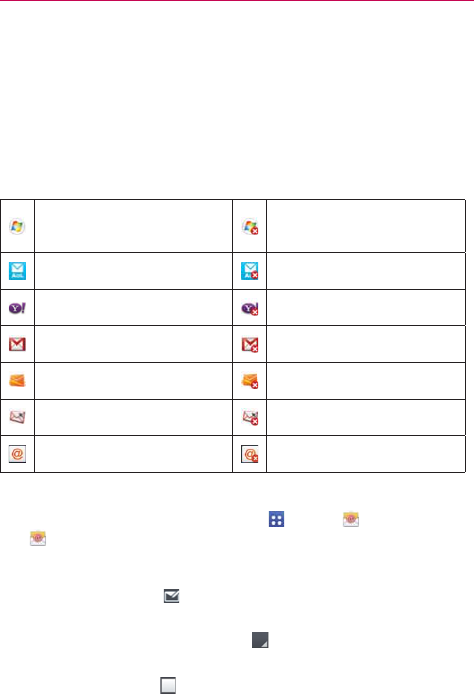
93
Communication
Email
The Email application allows you to read email from services other than
Gmail™. The following account types are supported: Microsoft Exchange,
Windows Live Hotmail, Yahoo! Mail, Gmail, AOL Mail, Verizon, and other
accounts.
Email icons
Exchange mail message
received
Exchange mail message
sending or receiving failed
AOL mail message received AOL mail message sending or
receiving failed
Yahoo! mail message received Yahoo! mail message sending
or receiving failed
Gmail message received or
sending was successful
Gmail message sending or
receiving failed
Hotmail received Hotmail message sending or
receiving failed
Verizon.net mail received Verizon.net mail message
sending or receiving failed
Other mail receivedl Other mail message sending
or receiving failed
To open the Email application
From the Home screen, tap the Apps Key > Email or tap the Email
icon directly from the Home screen.
Using the Email application
Tap the Compose icon in the upper right-hand corner to compose a
new message.
Tap the Accounts drop-down list icon to switch between your email
accounts.
Tap the Select all icon in the upper left-hand corner to select all of
your messages. Then you can tap Mark read/unread, Move to, or
Delete at the bottom of the screen.

94 Communication
Tap the checkbox next to a message, then you can tap Mark unread,
Move to, or Delete at the bottom of the screen.
Tap the Favorite icon next to an email message to designate it as an
important or favorite message.
The first time you open the Email application, a setup wizard opens to help
you add an email account. After the initial setup, the Email application
displays the contents of your Inbox.
Message search
Tap the
Menu Key
(in the Front Touch Keys bar), tap Search, enter the
text you are looking for, then tap the Search icon on the on-screen
keyboard.
The Accounts list
The Accounts list displays all of your email accounts.
Open the Email application. Tap the Accounts drop-down list icon
at the top of the screen.
Each account in the Accounts list displays the number of unread mail.
Tap an account to view its Inbox.
The account from which you send email by default is indicated by a
red vertical line on the left side of the account when viewing your
combined accounts.
NOTE While viewing the combined list of your email messages, default email account
messages are indicated by a vertical red line along the left side if the list.
Reading Your Email
You can read your email from the Inbox, or from other folders within each
individual contents, then tap a message entry to open it.
To read an email
From the Accounts list, simply tap any account to display that account’s
folders and contents.

95
Communication
To go to the folder list of the account tap the Menu Key (in the Front
Touch Keys bar), then tap Folders from the Inbox.
NOTE When new email arrives, a notification appears in the Status Bar. Drag the Notifications
panel downward and tap the email notification.
Email settings
From the Email application, tap the Menu Key (in the Front Touch Keys
bar), then tap Settings.
General settings
Tap Set default account to select which email account to designate
as your default account.
Tap Roaming to checkmark this setting to automatically retrieve email
while roaming outside your home network. Data fees will be charged.
Tap Email preview to set how many lines of email text to download
on your device for preview.
Tap Split view to display your email list on the left and an open email
message on the right when the phone is held in landscape orientation.
Tap Load linked images to select when you want to load linked
images.
Tap Ask before deleting to checkmark this setting if you want to be
asked before deleting email.
Tap Screen after deleting to select which screen to display after
deleting an email.
Tap Geotagging notification to checkmark this setting to display a
notification pop-up when sharing pictures with location information.
Tap Share pictures to set whether location information is included in
the picture file.
Tap Trusted certificates to view the list of trusted certificates that you
added.

96 Communication
ACCOUNTS
Tap an account to access settings specific to that email account including:
DISPLAY NAMES
Tap Account name to change the name to easily identify the account.
Tap Your name to change your name displayed with your sent email.
Tap Use signature to checkmark this setting to send a signature with
your emails.
Tap Signature to change the signature sent with your emails.
SYNC, SEND & RECEIVE
Tap Update schedule (for Exchange accounts) to choose the
schedule for updating email.
Tap Folders to sync (for Exchange accounts) to select what folders
you want to sync.
Tap Days to sync email (for Exchange accounts) to select how many
days you want to sync email for.
Tap Message format (for Exchange accounts) to set what format you
wish to receive email in.
Tap Retrieve interval to set the schedule to retrieve your email.
Tap Number of emails to show to set the number of emails to
display.
Tap Message size limit to set the maximum message size your
device receives and displays automatically. To view a message that
exceeds the limit you set, tap Load full message at the bottom of the
screen.
Tap Download over Wi-Fi to set large attachments to be queued for
download until Wi-Fi is connected.
Tap File size to download over Wi-Fi to select the size limit for
downloading files over Wi-Fi.
Tap Accounts to access your accounts and sync information.

97
Communication
Tap SMS sync (for Exchange accounts) to synchronize email
messages for every SMS.
Tap Calendar events to sync (for Exchange accounts) to select how
long you want to sync your Exchange Calendar events.
Tap Auto resend times to set the number of tries to resend a failed
email message.
Tap Always Cc/Bcc me to automatically insert your mail address in
the Cc field or the Bcc field (or select Off) when you compose an
email.
Tap Out of office settings (for Exchange accounts) to configure your
out of office message.
Tap Security settings to set digital signatures and encryption to
secure email.
Tap Corporate directory (for Exchange accounts) to search online
directory for recipients.
Tap Server policy (for Exchange accounts) to view the current server
policy.
NOTIFICATIONS
Tap Notifications to checkmark this setting to display new email
notifications.
Tap Notification sound to set the sound when you receive new email
notifications.
Tap Vibrate to set when the device will vibrate for a new email
notification.
SERVER SETTINGS
Tap Exchange server settings (for Exchange accounts) to manually
change your Exchange server settings.
Tap Incoming server settings to view and/or modify your incoming
server settings.
Tap Outgoing server settings to view and/or modify your outgoing
server settings.

98 Communication
REMOVE ACCOUNT
Tap Remove account to remove the account.
To add an account
From the Email application, tap the Menu Key (in the Front Touch
Keys bar) > Settings > Add account. Then, configure the new email
account settings as necessary.
Voicemail
The Voicemail application allows the management of voicemail directly from
the device rather than accessing voicemail via traditional methods.
Voicemail can display a list of your messages allowing you to choose which
message(s) to listen to or delete, without having to dial into your mailbox
and listen to voice instructions or prior messages.
To be able to use Voicemail
1. From the Home screen, tap the Apps Key > Voicemail or tap
Voicemail directly on the Home screen.
NOTE Listening to voicemail and setting up your voicemail service depends on subscription to
the visual mail service. When you tap the Voicemail Key on the dialpad, and you have
subscribed to the visual mail service, the Visual Voicemail application will be launched. If
you are not subscribed, you will be dialed into your traditional voicemail box.
2. The first time you access the Voicemail application, you will have to
subscribe to the Visual Voicemail service to be able to use it.
3. After subscription to the Visual Voicemail service, you will be prompted
to enter the password. To change the password call voicemail (dial *86).
4. After entering the password, your voicemail entries will be displayed in
your Inbox.
While viewing the voicemail list, you can select an entry (see step 5). For
additional options, tap the Menu Key (in the Front Touch Keys bar).
The following options are available: Search, Delete, Save as, Mark as
heard, Sort by, Saved voicemails, Refresh, Settings, Logout, and
Unsubscribe.